|
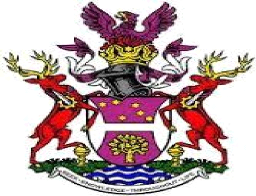
University of Hertfordshire Business School
Masters of Science in Project Management
Project Selection and Management in International Development
Organisations
Author: Landry Iragi Mugaruka
Student No: 12019699
Supervisor: Mike J. Herman
Submission Date: 23rd September 2014 Ethics Number:
BUS/PG/UH/00502
Acknowledgement
I would like to register my deepest appreciation to my supervisor
Mr. Mike J. Herman for being an instrumental part of my dissertation research.
His availability, guidance and direction made everything much easier and I
learned a great deal under his stewardship.
My sincerest thanks also go to my parents Gaspard and Denise, who
have been eternally supportive and provided me with invaluable input throughout
my course work. Warm thanks are also due to my siblings Tino, Serge, Rabi,
Clovis, Urbain and Linda for their useful recommendations and inspiration.
Finally, I dedicate this thesis to my lovely daughter Leyla, from
whom I get endless inspiration to do the very best.
Abstract
Selecting programmes and projects that are in line with strategic
goals and objectives has been described as the primary objective of
organisations today. For International Development Organisations, selecting the
right mix of projects is even more crucial because of their purpose, the
specific nature of the programmes and projects they implement and the
environment in which they operate. This dissertation proposes a simple and
flexible multilevel Framework, based on the principles of Project Portfolio
Management, that can be used when selecting and implementing development
programmes and projects while at the same time ensuring that they are in line
with the strategic orientation of the implementing organisation.
Table of Contents
Acknowledgement i
Abstract iii
Table of Contents iv
Table of Figures vi
Table of Tables vi
1. Introduction 1
1.1 Background 1
1.2 Research Question 2
1.3 Aims and Objectives of the Dissertation 2
1.4 Research Scope 3
2. Literature Review 4
2.1 Project Portfolio Management 4
2.1.1 What is Project Portfolio Management 4
2.1.2 Corporate Strategy 5
2.1.3 Project Portfolio Selection Process 6
2.1.4 Project Selection Tools and Techniques 7
2.1.5 Decision Support for Portfolio Selection 8
2.2 International Development Organisations 13
2.2.1 Nature of International Development Projects (ID) 13
2.2.2 Approaches to managing International Development Projects
14
2.2.3 Critical success factors for International Development
Projects 17
3. Methodology 19
3.1 Research Philosophy 19
3.1.1 Epistemology 19
3.1.2 Ontology 20
3.1.3 Axiology 21
3.2 Research Approach 21
3.3 Research Design and Strategy 22
3.3.1 Research Design 22
3.3.2 Research Strategy 23
3.4 Time Horizons 25
3.5 Limitations 25
4. Findings and Analysis 27
4.1 Findings 27
4.1.1 Action Aid International 27
4.1.2 OXFAM UK 29
4.1.3 Plan International 31
4.1.4 Christian Aid UK 32
4.1.5 Water Aid UK 34
4.2 Funding of International Development Organisations 35
4.3 Analysis 36
4.3.1 Strategy 36
4.3.2 Project Selection and Management 37
4.3.3 Selection Criteria 40
5. Recommendations 42
5.1 Programme Selection Committee 42
5.2 Selection and Management Tools 44
5.3 Programme and Project Selection Framework 47
6. Conclusion 51
6.1 How is Project Portfolio Selection applied within an
Organisation 51
6.2 What is the nature of International Development
Organisations as opposed to
traditional Organisations 51
6.3 What is the proposed framework for the selection and
management of
International Development Programmes and Projects 51
7. References 53
7.1 Referred Reports 57
7.2 Reports Not Used 58
8. Personal Reflection 60
Appendix 1 APPLICATION FOR ETHICAL APPROVAL OF A STUDY
INVOLVING
HUMAN PARTICIPANTS 62
Appendix 2 Dissertation Proposal 80
Appendix 3 Dissertation Log 87
Table of Figures
COOPER'S STRATEGIC PORTFOLIO MANAGEMENT FRAMEWORK 9
ARCHER AND GHASEMZADEH FRAMEWORK FOR PORTFOLIO SELECTION 10
ENGLUND AND GRAHAM FRAMEWORK FOR PORTFOLIO SELECTION 12
PROPOSED ORGANISATIONAL STRUCTURE 44
PROPOSED WEIGHTED SCORING MODEL 46
PROPOSED FRAMEWORK FOR PROGRAMME SELECTION AND MANAGEMENT
48
PHASES 1 AND 2 OF THE PROPOSED FRAMEWORK 49
PHASES 3 AND 4 OF THE PROPOSED FRAMEWORK 50
Table of Tables
DFID CIVIL SOCIETY ORGANISATIONS FUNDING (2014) 35
SUMMATIVE TABLE OF THE ANALYSIS AND DISCUSSION 40
University Of Hertfordshire (2014)
1
1. Introduction
1.1 Background
Implementing Strategic Objectives through projects has been the
aim of many organisations (Gardiner, 2005; Englund & Graham, 1999; and
Srivannaboon & Milosevic, 2006) but many of the projects being implemented
have little or no significant tie to the strategic objectives they are meant to
be supporting (Englund & Graham, 1999). Selecting the right mix of projects
is therefore one of the most important task in project-based organisations to
ensure the achievement of their strategic objectives within their constrained
resources and capabilities. Several tools and techniques which aim to help
organisations select projects for their portfolios are available with each tool
and technique having both advantages and disadvantages. Organisations therefore
have a wide range of methods they can choose from in order to make their
project selection process more effective. However, the adoption of any of these
tools and techniques requires the development of a comprehensible framework
that will support the organisation's portfolio selection. The importance of
project selection in project-based organisations is widely recognised but as it
was observed by Dye and Pennypacker (2000); a clear and formal project
selection and prioritisation process is too often lacking thus leading many
researchers and practitioners to develop their own project selection frameworks
integrated with tools and techniques (Archer & Ghasemzadeh, 1999; Englund
& Graham, 1999; and Cooper et al., 2001).
International Development Organisations are project-based
organisations whose goals are in line with the United Nations Millennium
Development Goals and range from ending poverty to halting the spread of HIV
and Aids. International
Development Projects differ from other projects because of the
environment in which they are implemented (Ika et al., 2010) with complexity,
resistance to change, competing stakeholders' agenda and the contradictory
expectations of the different parties involved in the implementation of such
projects (Crawford and Bryce, 2003; Diallo and Thuillier, 2005) being the
factors that that have an impact on the successful implementation of such
projects. The sole nature of International Development Projects in comparison
to the traditional sector in which Project Management tools and techniques are
used resulted in International Development
University Of Hertfordshire (2014)
2
Projects not getting enough attention in literature
(Themistocleous and Wearne, 2000; Diallo and Thuillier, 2004) hence there is no
clear universal framework that be used when selecting and implementing these
types of projects.
1.2 Research Question
This dissertation aims to answer the following question:
«How can programmes and projects be selected and managed
in an International Development Organisation to ensure the successful
implementation of its strategy?»
1.3 Aims and Objectives of the Dissertation
This dissertation aims to highlight how some the principles of
Project Portfolio Management can be applied when implementing international
development projects. After working for two years in an International
Development Organisation in East Africa, I came to the realisation that our
biggest challenge was the selection of the right mix of projects that were in
line with our three strategic pillars: Access to Markets, Competitive
Enhancement and Access to Finance. The only way through which we could make it
possible for the different organisations working with us to benefit from our
support (both technical and financial) was through the implementation of
projects. The projects were brought to us by the local organisations and the
only tool we used to rank and prioritize these projects was a Balanced
Scorecard which in our case only measured the managerial capabilities of the
local organisations; in other words we used it to judge whether or not the
given organisation was able to manage the project's budget and if there was a
person within the organisation capable of ensuring the successful
implementation of the project. The tool we used to select and prioritize
projects did not guarantee that the selected project would be completed within
the agreed time, scope, and budget nor that the project deliverables would be
in line with our strategic objectives. This led me to conclude that our
selection process was not effective enough and its lack of effectiveness had a
direct impact on the way the projects were implemented and their successful
completion. The importance of project portfolio selection and management, how
proper portfolio management leads to the successful implementation of corporate
strategies and how project portfolio management principles and processes can be
applied when selecting and managing International Development Projects will be
discussed throughout this dissertation. The objectives of this dissertation
are:
University Of Hertfordshire (2014)
3
- to understand how project portfolio selections can applied
within an organisation
- to understand the nature of International Development
Organisations as
opposed to traditional project-based organisations, and
- to propose a framework for the selection and management of
programmes
and projects in International Development Organisations
1.4 Research Scope
The focus of this dissertation is the selection and management of
International Development projects with the aim of developing a framework that
can be used by International Development Organisations worldwide. Project
management and Project Portfolio Management have been accepted by both
academics and practitioners as being respectively about «doing the project
right» and «doing the right project» (Cooke-Davies, 2002; &
PMI, 2004, 2006), it is therefore important for International Development
Organisations to be able to select the right mix of projects and manage them
accordingly in order to achieve their strategic objectives.
Turner (1994) observed that Western-oriented tools and techniques
of project management can not a be applied in non-western countries because of
the different cultural differences hence both the project selection and
management tools and techniques used have to consider these cultural
differences.
This dissertation will review the Project Portfolio Management
literature with an emphasis on the different tools, techniques and frameworks
it proposes and the impact they have on the successful implementation of
corporate strategies. A review of literature on of International Development
organisations will also be conducted to understand both the nature of this type
of organisation, some of the critical success factors for development projects,
and some of the challenges faced when implementing these projects.
University Of Hertfordshire (2014)
4
2. Literature Review
This Literature review is aimed at improving our understanding of
both the theoretical and practical concepts that constitute Project Portfolio
Management. The review is divided into two parts: the first part looks at
Portfolio Management with a focus on the project selection process, the
different tools and techniques that can be used and the frameworks that can be
used to select projects for a portfolio. The second part of this literature
review looks at International Development Organisations and what makes them
different from traditional organisations.
2.1 Project Portfolio Management
2.1.1 What is Project Portfolio Management
Project management can be defined as a process by which projects
are defined, planned, monitored, controlled and delivered (APM, 2006). The aim
of this process is the achievement of well-defined objectives. How is project
management different from project portfolio management? Different authors have
tried to answer this question to show the gap that portfolio management aims to
fill. Levine (2005) argues that project portfolio management is the bridge
between portfolio planning and portfolio management within a traditional
organisation. Project portfolio management therefore links the organisation's
strategic objectives to its project selection process by ensuring that
individual project goals are in line with the portfolio's goals. LaBrosse
(2010) on the other hand argues that project portfolio management is a way
companies can collectively manage a group of projects to reap benefits that
would not be available if the projects were managed individually. The two
authors put emphasis on the benefits that linking an organisation's strategic
goals and objectives to its project selection process can bring for that
organisation. This dissertation as explained previously focuses on the project
selection process as part of project portfolio management therefore a good
understanding of an organisation's strategic goals and objectives is crucial in
order to make its project selection process more effective. Dye and Pennypacker
(1999) argue that project portfolio management is the application of knowledge,
skills, tools and techniques to a collection of projects as opposed to a single
project's activities to meet or exceed the needs and expectations of an
organisation's investment strategy. Project portfolio management is therefore
not only about linking strategies and goals to the project selection process
but also about applying the existing knowledge and tools to
University Of Hertfordshire (2014)
5
the project selection process. The PMBOK (2010) refers to project
portfolio management as the selection and support of project investments that
are guided by the organisation's strategic plan and the available resources.
The resources available within an organisation have an impact on the way the
project portfolio is selected. Cooper et al (1998) suggest that project
portfolio management has the following three objectives: maximising the value
of the portfolio, linking the portfolio to the strategy; and balancing the
portfolio.
2.1.2 Corporate Strategy
Shendar et al. (2001) argue that project portfolios are powerful
strategic weapons therefore they can be described as building blocks in
implementing an organisation's intended strategy. Muller et al. (2008) on the
other hand state that there exist a positive relationship between strategic
portfolio selection and project portfolio performance. Understanding the
strategic orientation of an organisation is therefore crucial when wanting to
implement project portfolio management processes. Various definitions exist in
literature for the term `strategy'; early strategic management
literature puts emphasis on the activities that are undertaken by an
organisation in order to maintain its competitive advantage when defining
strategy (Chaffee, 1985). The focus on competitive advantage is also supported
by Walker and Ruekert (1987) who describe business strategy as the way in which
an organisation decides to compete in a given industry in comparison to what
its competitors are doing. Yelin (2005) argues that every organisation has a
strategy therefore there cannot be a single, definitive definition of the term.
For the purpose of this dissertation which focuses on project portfolio
selection in International Development Organisations, the term strategy will be
defined using the Five P's of Strategy proposed by Mintzberg et al (1998)
because of the specific nature of this type of organisations:
- Plan: strategy is a direction, guide or course
of action into the future that an organisation follows
- Pattern: the organisation's strategy is
consistent over time
- Position: strategy is a means of locating the
organisation in its external environment
University Of Hertfordshire (2014)
6
- Perspective: strategy looks into inside the
organisation and is applied throughout
- Ploy: strategy is a specific manoeuvre
intended to outwit an opponent or a competitor
Strategy is therefore the direction that an organisation follows
over a long period of time and which helps it achieve its objectives in a
changing environment (Johnson et al, 2006).
2.1.3 Project Portfolio Selection Process
Projects as we know them can be defined as being temporary
endeavours undertaken to create a unique product, service or result (PMI,
2006). To create this unique product or service, a well-defined process
consisting of interrelated activities as to be followed (APM, 2006). This
process converts inputs into outputs. Project portfolio selection has become
increasingly popular in recent years as illustrated earlier in project-based
organisations. The PMI (2008) defines the project portfolio selection process
as the process which ensures that projects are reviewed to ensure that
organisational resources are allocated accordingly and that the management of
the projects in the portfolio is consistent with and aligned to the
organisation's strategy. Englund and Graham (1999) argue that the project
portfolio selection process begins with the establishment of an upper
management team. The role of this management team is to set directions for the
portfolio, manage multiple projects or a set of projects, decide on the
selection criteria, and aid in cross-organisational issue resolution. The goal
of this management team is to ensure that the projects in the portfolio support
the organisation's strategy. The APM (2006) describe the project portfolio
selection process as a process that is concerned with screening, analysing, and
appraising the characteristics of a project or group of projects in relation to
the organisation's strategy. The strategic alignment of the projects selected
for the portfolio is therefore crucial within organisations. Levine (2005)
argues that the project portfolio selection process' aim is to help the
organisation rank projects according to their value and benefits, the risks of
achieving these benefits, the resources available to the organisation to help
support the implementation of the projects in the portfolio and the size of the
pipeline. He later on argues that the project portfolio selection process is
made up of two sub-processes:
University Of Hertfordshire (2014)
7
the selection and prioritization of projects and the management
of the selected projects. These two sub-processes are directly linked to the
organisation's strategic objectives in that they help in executing the
strategic plan set by the organisation with a focus on meeting both the
individual project's goals and the portfolio goals. The project portfolio
selection process is not as straight forward as it might seem; factors such
conflicting objectives, unavailability of resources, uncertainty and risk can
turn it into a very complex process as it was observed by Ghasemzadeh and
Archer (2000). The strategic focus of the portfolio selection process should
therefore take into consideration of these factors to ensure that the process
is effective.
2.1.4 Project Selection Tools and Techniques
Project selection tools, techniques and models are used by the
project selection team to evaluate both the qualitative and quantitative
characteristics of a given project or a group of projects. Their aim is to help
the project selection team select the project or group of projects that is
consistent with the strategic goals of the organisations. Souder (1973)
identified five criteria for project selection models:
- Realism: the model should reflect the
organisation's objectives and be applied throughout. The model should also take
into account the resource availability within the organisation
- Capability: the project selection model should
be able to deal with uncertainties
- Flexibility: the project selection model
should give clear results and be easy to modify when responding to specific
changes.
- Ease of use: The project selection model
should be convenient, easy to understand and use without requiring special
interpretation.
- Cost: the cost associated with using the
select project selection model should be low relative to the cost of the
projects and less than their potential benefits.
Meredith and Mantel (2010) argue that there are two types of
project selection models:
- Numeric project selection models: they use numbers as inputs
but the criteria they measure can be either objective or subjective.
- Non-numeric models: they do not use numbers as input.
University Of Hertfordshire (2014)
8
Furthermore, Cooper et al. (2001) broke down the project
selection models into five categories when discussing their popularity and
dominance for project selection and portfolio management:
- Use of financial methods: financial models are
used to rank projects against each other by determining their expected economic
value
- Use of strategic approach: these approaches
are concerned with the allocation of resources in the different strategic
buckets or categories within the organisation
- Use of scoring models: these models are used
as a ranking and prioritization tool with the project scores used to rank
projects against each other. The criteria mainly used with the scoring models
are the strategic fit, financial rewards and the risks.
- Use of bubble diagrams: these diagrams are
used to support the decision making process.
- Use of check list models: check lists act
as a supporting tool and are employed to make Go/Kill decisions on individual
projects.
Their study showed that organisations tend to use a combination
of tools, techniques, methods and models instead of one alone to boost their
chances of selecting good projects for their portfolios.
2.1.5 Decision Support for Portfolio Selection
Having understood the aim of the project portfolio selection
process, one important question still has to be answered; which project or
group of projects should be included in the portfolio? Different tools and
techniques are available for project portfolio selection hence making it easier
for an organisation to select the one that best matches its purpose. There is
however a lack of framework that would arrange both these tools and techniques
in a logical manner. It is therefore important for an organisation to adapt or
develop a framework that can used to evaluate project proposals and select a
portfolio which is in-line with its strategy (Sommer, 1999). Difficulties that
are associated with project portfolio selection are often caused by the
following factors according to Ghasemzadeh and Archer (2000): (1) multiple and
often conflicting objectives, (2) qualitative project objectives, (3)
uncertainty and risks which affect projects, (4) an unbalanced portfolio in
terms of factors such as risk and completion time, (5) independence amongst
projects and (6) an enormous number of
University Of Hertfordshire (2014)
9
feasible portfolios. It is important to develop a framework that
aims to address all these difficulties and at the same time takes advantage of
the different tools and techniques available. The frameworks that will be
presented in this section are the most widely cited in literature:
2.1.5.1 Cooper's Framework for Strategic Portfolio
Management Cooper (2005) proposes a hierarchical process made up of
two levels of decision making for project portfolio selection. These two levels
answer the following questions:
- Where should the business/organisation spend its funds?
- How should the resources be split across the different
projects? - What specific projects should be taken on board?
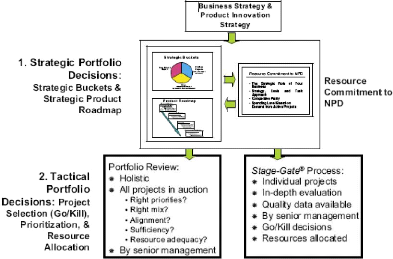
Figure 1 Cooper's Strategic Portfolio Management
Framework
The first level of Cooper's Framework called the Strategic
Portfolio Decisions is concerned with the strategy that the organisation
will follow when selecting projects for its portfolios and how the
organisation's resources will be utilised. This level helps in the
establishment of a Road Map for project portfolio selection in the
organisation. The second level of Cooper's Framework called Tactical
Portfolio Decisions is concerned with project selection, prioritization
and resource allocation. Projects are
University Of Hertfordshire (2014)
10
looked at individually on this level following the strategy set
on Level 1. Different tools and techniques are used on this level to select the
right projects that fit the agreed portfolio's strategy.
2.1.5.2 Archer and Ghasemzadeh Framework
To address the difficulties mentioned earlier, Ghasemzadeh and
Archer (2000) propose a framework which combines methods commonly used when
selecting projects for a portfolio because of their desirable decision support
characteristics. This framework is made up of two main phases: the
Pre-process stage and the Post-process stage; each made up of
sub-stages.
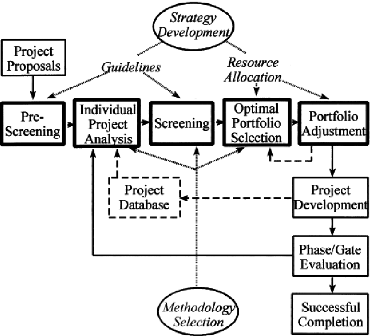
Figure 2 Archer and Ghasemzadeh Framework for Portfolio
Selection
The pre-process stage provides a guideline for the
general project portfolio selection process and helps the organisation in
determining the strategic focus of the portfolio and its resource constraints.
This stage also helps in the selection of a methodology including the different
techniques that will be used for the project portfolio selection. The following
sub-stages make up the Pre-process stage:
University Of Hertfordshire (2014)
11
- Pre-screening stage: during this stage,
projects proposals are analysed and only the projects that fit the strategic
focus of the organisation will be selected
- Individual project analysis: during this
stage, a set of parameters such as net present value or internal rate of return
will be calculated for each individual projects then used to compare the
selected projects
- Screening: attributes from the previous two
sub-stages are examined during this stage to eliminate any project that does
not meet the pre-set selection criteria.
The aim of the Pre-process stage is to eliminate projects that do
not fit the organisation's strategic goals and objectives therefore making it
the work of the project committee easier. The Post-process stage consists of
the following subprocesses:
- Optimal portfolio selection: projects are
matched against different objectives set for the portfolio while at the same
time considering factors such as the organisation's resource availability,
project timing, etc.
- Portfolio adjustment: during this final stage,
the decision makers apply their knowledge and experience to balance and make
adjustments to the portfolio by adding and deleting projects.
Archer and Ghasemzadeh's Framework for project portfolio
selection support Cooper (2005)'s critical factors for project portfolio
selection, i.e. alignment with corporate strategy, value maximization and right
balance and mix of projects.
2.1.5.3 Englund and Graham Framework
Englund and Graham (1999) framework is based on a study they
conducted at Hewlett-Packard and is concerned with selecting projects for their
strategic emphasis therefore creating an environment for successful projects
within the organisation. This framework consists of a series of steps that help
link projects to the organisation's strategy and it can be applied to any type
of organisation.
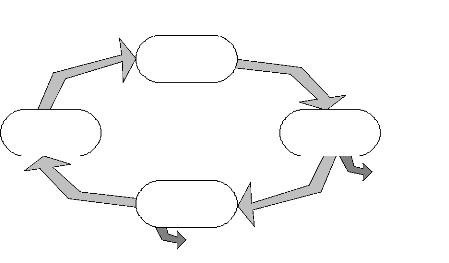
12
3. Decide
I list projects
I requirements
I capacity
I critical few
I out-plan
I prioritized list
I desired mix
I decision
I in-plan
I use
I fully fund
I communicate
I update
I people
I goals I
categories I
criteria
1. What
should do
4. Do it!
2. What
can do
I rejects
University Of Hertfordshire (2014)
Figure 3 Englund and Graham Framework for Portfolio
Selection
The focus of the framework is on developing cooperation across
the organisation to fulfil the overall strategy of the organisation. The
following four steps make up this framework:
- What the organisation should do: This step is
concerned with the identification of the people who will be deciding which
projects should be taken on board and the overall goal (s) of the whole
portfolio. Projects are also put into different categories to facilitate their
analysis by the project selection team. This idea of categorising projects is
similar to Cooper (2005)'s Strategic Buckets which give the organisation a
clear picture of what it is involved in. Furthermore, criteria should be set
within each category to assess whether or not a given project is in line with
the agreed goals of the portfolio.
- What the organisation can do: this step is
concerned with the evaluation of projects by the project selection team through
analysis and debate with a focus on the characteristics of the projects. As a
result of this evaluation process, certain projects will be eliminated while
others will be adjusted in respect with the priorities set in the strategy. The
second part of this step is concerned with the identification of the resources
both within and outside the organisation that will be required when
implementing the projects.
University Of Hertfordshire (2014)
13
- Analyse and decide on projects: a comparison
between the estimated resources and the available resources is done during this
step to prioritize the selected projects with a focus on their benefits.
Different project selection tools and techniques can be used during this step
but the authors suggest that using the Analytical Hierarchy Process is the
better alternative.
- Implementation: the selected projects can
finally be implemented following a well-defined plan that will serve as a
guideline for the management team when allocating resources and monitoring
progress and change.
2.2 International Development Organisations
2.2.1 Nature of International Development Projects
(ID)
International development projects are concerned with poverty
alleviation, living standards improvement, environment protection, capacity
building and the development of basic physical and social infrastructure (Khang
and Moe, 2008). Ika (2012) argues that international development projects are
technical, social and political undertakings. They are social because they aim
to improve directly or indirectly the wealth of the population and political
because the choice of project's options often results from a political decision
made by either the International development agency, the donors or the local
political leaders or policy maker (Diallo & Thuillier, 2004, 2005).
International development projects can be blueprint (physical capital-based)
projects or process (human-capital-based) projects (Bond and Hulme, 1999; Ika
and Hodgson, 2010). Blueprint projects are typical infrastructure projects that
provide a package of goods and services for low income beneficiaries (Morgan,
1983) while process projects include projects that deal with education, health
and capacity building. The social objectives of International development
projects are less tangible and have less visible and measurable objectives when
compared to projects in other sectors. This intangibility of project
deliverables requires the development of a new body of knowledge or the
adaption of the existing body of knowledge to help monitor the implementation
of International development projects. International development projects also
have a variety of stakeholders which makes them very complex as it was observed
by Youker (1999).
University Of Hertfordshire (2014)
14
They usually involve three separate stakeholders namely: the
funding agency which finances the project but does not benefit from its
outputs, the implementing unit which is in charge of managing project
activities from the initiation phase to its completion, and the targeted
beneficiaries who actually benefit from the project's outputs. Like other types
of projects, International development projects have a life cycle that has been
discussed widely in literature (Baum, 1970; Rodinelli, 1976; Youker, 2003;
Ahsan and Gunawan, 2010; Londoni and Corti, 2011). A six steps cycle that
provides a well-defined structure and direction for project activities while
keeping the focus on the development objectives of the projects was proposed by
Baum (1970, 1978). These steps are namely: identification, preparation,
appraisal, negotiation, implementation and supervision, and evaluation.
Radinelli (1976) however, suggest that well-planned international development
projects should follow a ten steps cycle: Identification and definition,
Formulation, preparation and design, Appraisal, Selection, negotiation and
approval, Activation and organisation, Implementation and operation,
Supervision , coordination and control, Termination and completion,
Dissemination of output and transition to normal administration,
Post-evaluation and follow-up. Due to the nature of International development
projects, Youker (2003) suggests that their life cycle should consider both the
Donor side of the implementation and the beneficiaries. He argues that the
Identification phase of the cycle should be carried out by both the donor
organisation and the beneficiaries to ensure that the projects identified meets
their needs.
2.2.2 Approaches to managing International Development
Projects Two main frameworks exist for managing International
Development projects: the Logical Framework Approach (LFA) and the Project
Management for Development Professionals (PMD Pro).
The Logical Framework Approach was developed for the United
States Agency for International Development (USAID) in the 1960's and was
described as a set of interlocking concepts used together to develop
well-designed, objectively-described and evaluable projects (Rosenberg and
Posner, 1979, cited in Hermano et al., 2013). The Logical Framework Approach
was introduced to (NORAD, 1999):
- Assist projects in establishing clear and realistic
objectives
University Of Hertfordshire (2014)
15
- Provide a basis for monitoring and evaluation and make planners
think in evaluator terms
- Improve communication between donor and recipient.
The Logical Framework Approach proposes seven steps for planning
development projects: participatory analysis, problem analysis, objective
analysis, alternative analysis, identification of project elements, development
of assumptions, and identification of project indicators. The first two steps
are concerned with the identification of the group or groups that will be
affected by the project and the problem that will be addressed. The third and
fourth steps are concerned with the transformation of the problem identified
into project objectives and the assessment of the different options available
for the project (technical, financial, environmental, etc.). The remaining
three steps form the project planning matrix of the Logical Framework Approach
and are concerned with the identification of the project goal, purpose,
outputs, activities and inputs. A description of the conditions outside the
control of the project that have to be met in order for the project to succeed
and the performance standard that have to be reached in order to achieve them
should also be provided. Despite its wide popularity in the development sector,
the Logical Framework Approach has been criticized in literature for various
reasons (Crawford and Bryce, 2003; Ika et al., 2012; Hermano et al., 2013).
These critics have highlighted the lack of body of knowledge of the Logical
Framework Approach in the monitoring and evaluation phase of the project
lifecycle has being its major drawback. Crawford and Bryce (2003) identified
the following four limitation of this framework: (1) the absence of time
dimension; (2) the inappropriateness of assigning efficiency-level objectively
verifiable indicators; (3) the inadequacy of the means of verification; and (4)
the static nature of the Logical Framework Approach. The application of
well-known project management standards to the Logical Framework Approach has
also been proposed as a possible means of addressing its limitations (Hermano
et al., 2013) in order to improve the performance of International Development
projects but as Khang and Moe (2008) observed, the uniqueness of international
development projects make the application of standardized tools and methods
difficult.
The Project Management for Development Professionals framework
(PMD Pro) was developed in 2010 by the Project Management for
Non-Governmental
University Of Hertfordshire (2014)
16
Organisations (PM4NGOs) International Group. This framework
provides guidelines for managing international development projects and it is
based on two assumptions: (1) project managers in the international aid
industry share similar challenges; (2) project managers in the international
aid industry can learn from project managers in other sectors. The PMD Pro is
organised into four sections (PMD Pro, 2013): Projects in the Development
Sector, Phases in the Life of a Development Project, Project management
Disciplines, and Adapting the PMD Pro. The first two sections of the framework
are concerned with the roles and responsibilities of the project manager when
managing international development projects and the importance of having
balanced project management throughout the lifecycle of international
development projects. The last two sections are concerned with the array of
project management disciplines that the project manager must apply throughout
the lifecycle of international development projects and how the PMD Pro
approach can be adopted by a development organisation. PMD Pro has been
described as an extension of the Logical Framework Approach by Hermano et al.
(2013) in that it mixes the Logical Framework guidelines with tools contained
in the widely used project management bodies of knowledge. The PMD Pro is built
around five principles:
1. Project management is balanced: equal rigor should be applied
throughout the project lifecycle
2. Project management is comprehensive: project management
disciplines should be used to manage all the work of the project
3. Project management is integrated: all the project
management aspects should be aligned and coordinated to ensure that project
elements run smoothly
4. Project management is participatory: the different
stakeholders should be involved during the project implementation to improve
quality, ensure transparency, increase human capacity and strengthen
stakeholder buy-in
5. Project management is iterative: the project management
processes should be revisited and repeated throughout the lifecycle to ensure
that the project is still relevant
University Of Hertfordshire (2014)
17
2.2.3 Critical success factors for International
Development Projects Literature on success factors and criteria for
international development projects is scarce which makes the identification of
success criteria in this sector difficult. An exploratory study of the success
criteria for international development projects in sub-Saharan Africa conducted
by Diallo and Thuillier in 2004 was the first empirical research on the
subject. Their research assessed project success as perceived by its key
stakeholders: the project coordinator, task managers, supervisors, project
team, steering committee, the beneficiaries, and the population. The resultant
set of criteria identified from the research include beneficiaries'
satisfaction, conformation of goods and services produced to the project
documents, achievement of project objectives and completion of project within
time and budget. Khang and Moe (2008) later grouped the success criteria
identified by Diallo and Thuillier for international development projects into
three main categories: Competencies, Motivation, and Enabling
Environment. Competencies relate to the project manager and the project
team members and are directly linked to their ability to perform project tasks
successfully. The competencies can be technical, interpersonal and
administrative. Motivation relates to the willingness to perform and the
dedication to the success of the project by the project manager and the project
team members. Motivation and competencies go hand in hand in this case because
without motivation, competencies will have no impact on the project. The
enabling environment refers to the relationship between the project's internal
and external environment. An enabling environment will provide adequate support
from the key stakeholders to the project manager thus facilitating the
implementation of the project. Furthermore, Hermano et al. (2013) identified
seven critical success factors for international development projects that they
later used to compare the Logical Framework Approach to the Project Management
for Development Professional (PMD Pro) approach. The success factors they
identified are also based on Diallo and Thuillier's research and other
researches on success factors for development projects. They identified the
following success factors: team building, local environment, implementation
approach, learning opportunities, policy characteristics, availability of
resources, and stakeholders/beneficiaries' satisfaction. Team building is
concerned with the characteristics of the project team members as mentioned by
Khang and Moe (2008) and the impact that proper competencies mixed with
motivation can have on the implementation of international development
projects. As Youker (2003) observed,
University Of Hertfordshire (2014)
18
the environment in which development projects are implemented is
quite complex and uncertain therefore using `'what if» scenarios when
selecting the right implementation approach becomes necessary. Transferring
knowledge to the beneficiaries is viewed as one of the most important goals of
international development projects therefore creating learning opportunities is
crucial. The implementation of international development projects must take
into account the characteristics and plans of the country in which the project
is being implemented (Rosenberg and Posner, 1979) therefore understanding local
policies with contribute to the successful implementation of development
projects.
University Of Hertfordshire (2014)
19
3. Methodology
This section of the dissertation will highlight the different
research philosophies, approaches strategies that can be used when doing a
research and it will give an explanation the research philosophy, approach and
strategy used for this dissertation.
3.1 Research Philosophy
3.1.1 Epistemology
Epistemology is concerned with what constitutes acceptable
knowledge in a field of study (Saunders et al., 2007). It is the study of what
we know about reality and it depends on what we believe reality is (Lee and
Lings, 2008). There are three main types of epistemology: Positivism, Realism
and Interpretivism.
Researchers who adopt a positivist stance are similar to natural
scientists in that they only work with observable phenomena that will lead to
the production of credible data (Saunders et al., 2007). Positivist researchers
collect data and use existing theories to develop hypotheses.
Realism is similar to positivism in that it advocates the use of
a scientific approach to develop knowledge. Direct realism says that what we
experience through our sense portrays the world accurately while critical
realism argues that what we experience are sensations or images of things in
the real world not the things directly (Saunders et al., 2007).
The interpretivism advocates that the truth cannot be determined
in any absolute way and the purpose of an interpretivist inquiry is to gain
sufficient understanding about a phenomenon in order to predict the future
(Jankowicz, 2005). Researchers that adopt the interpretivist stance enter the
social world of their research subjects and understand it from their point of
view.
The epistemology chosen for this dissertation is interpretivism
because this research aims to understand how projects are selected in
International development organisations and to develop an alternative theory in
the form of a framework based on the principles of Project Portfolio Management
that can be used to select and manage development projects while at the same
time assuring the achievement of the strategic objectives of the organisation.
The interpretivist approach is appropriate
University Of Hertfordshire (2014)
20
for this research because as it was discovered, no general
framework can be said to be the one that is best suited for International
Development Projects but instead, each of the organisations part of the sample
selected, used tailored made framework that best suit their objectives. The
findings show that because of the uniqueness and complexity of international
development programmes and projects, they are not restricted to one unique
framework therefore making this dissertation relevant in that it aims to
develop an alternative framework for project selection and management in
International Development Organisations which will be an addition to the
existing knowledge in the international development field.
3.1.2 Ontology
Ontology as opposed to epistemology is concerned with the nature
of reality (Saunders et al., 2007). There exist two different aspects of
ontology: Objectivism and Subjectivism.
Objectivism argues that social entities exist in reality external
to social actors concerned with their existence (Saunders et al., 2007).
Subjectivism on the other hand argues that social phenomena are
created from the perceptions and actions of social actors concerned with their
existence.
The ontology chosen for this research is subjectivism because it
supports the interpretivism epistemology. The subjectivist view studies the
details of a situation in order to understand reality (Remenyi et al., 1998).
To understand how International Development Organisation operate, a critical
literature review on the this area was conducted and it focused on the nature
of these organisations, the two approaches that are widely used within these
organisations when it comes to selection of projects and finally the critical
success factors for international development projects. Prior to understanding
how International development organisation operate, Project Portfolio
Management was introduced with a focus on the selection process, the different
tools and techniques that can be applied, the different frameworks that can be
used for portfolio selection and the concept of strategy. The literature review
allowed me to find out about the different concepts of Project Portfolio
Management and it gave an insight on the current practices within the
International Development sector. This understanding prepared me for the next
task which was to analyse the documentation obtained on the five selected
organisations.
University Of Hertfordshire (2014)
21
3.1.3 Axiology
Axiology is concerned with the aims of the research (Lee and
Lings, 2008). The aim of this dissertation is to develop a framework based on
the principles of Project Portfolio Management that can be used for the
selection and management of International development projects.
In order to achieve this aim, the research first focused on
project portfolio management with the objective of understanding what it is and
how programmes and projects are selected and managed when applying the
principles of project portfolio management. Secondly, the research looked at
International Development Organisations as a whole in order to understand their
nature and what differentiate them from the other types of organisations, how
projects are selected and managed within this type of organisation and what
critical success factors lead to the successful implementation of International
Development Projects. Thirdly, five international development organisations
were analysed with a focus on their strategic objectives and their programme
selection framework. This analysis helped in identifying the key features of
their respective frameworks and how they function. Finally, a simple and easy
to implement framework based on the discussions in the literature review and
the findings was developed.
3.2 Research Approach
There are two types of research approach: Deduction and
Induction.
Deduction also known as theory testing is associated with
scientific research and it involves the development of a theory that will be
tested (Saunders et al., 2007). The deductive approach aims to explain
relationships between variables by using a highly structured methodology.
Induction which is associated with building theory is concerned
with the context in which events take place (Saunders et al., 2007). This
approach analyses events and use this analysis to formulate a theory.
The research approach selected for this dissertation is induction
because the aim of this dissertation is to understand both project portfolio
management and International development organisations in order to develop a
framework that can be used when selecting and managing development programmes
and projects. The building of this theory required the analysis of qualitative
date from five selected
University Of Hertfordshire (2014)
22
International Development Organisations in order to get more
insight on their strategic objectives, the way they are funded and the
framework they currently use to select and implement their programmes and
projects. The findings of this analysis lead to the development of the
framework proposed in this dissertation.
3.3 Research Design and Strategy
3.3.1 Research Design
Research design is the general plan of how you will answer your
research question based on your research purpose, research objective (s), the
sources of data collection and the constraints of your research (Saunders et
al., 2007). There exist three types of research purpose: exploratory,
descriptive and explanatory.
An exploratory study is a study which aims to find out what is
happening and asks questions to assess phenomena in a new light (Saunders et
al., 2007).
A descriptive study is one that aims to portray an event or
situation accurately (Saunders et al., 2007). It gives a clearly understanding
of events or situations prior to the collection of data.
An explanatory study on the other hand is one that aims to
establish a causal relationship between different variables (Saunders et al.,
2007). Explanatory studies put emphasis on studying a situation or problem in
order to explain relationships between variables.
This dissertation is a combination of both the exploratory
research approach and the descriptive approach. The research is exploratory in
that it aims to give an insight on what project portfolio management is about,
how it is used and finally how it can be applied in the programme and project
selection processes of International Development Organisations through to the
development of framework based on project portfolio management's principles.
The descriptive aspect of this research focuses on International development
organisations and aims to help understand the nature of this type of
organisation, what differentiate these organisations from organisations in
other sectors, the two commonly used frameworks in the project selection
process of the these organisations and the factors that lead to the successful
implementation of these projects. Combining these two approaches help meet the
research objectives which are:
University Of Hertfordshire (2014)
23
- to understand how project portfolio selections can applied
within an organisation
- to understand the nature of International Development
Organisations as
opposed to traditional project-based organisations, and
- to propose a framework for the selection and management of
programmes
and projects in International Development Organisations
3.3.2 Research Strategy
The research strategy is concerned with data collection and its
analysis (Saunders et al., 2007). The choice of research strategy is guided by
the research question, the objective (s) of the research and the amount of
resources available. The most commonly used research strategies are:
experiments, surveys, case studies, action research, grounded theory,
ethnography and archival research.
Experiments are a form of research strategy that aims to
establish causal links between variables and are widely used in exploratory and
explanatory research to answer used to answer `how', `why' questions and
typically involve an hypothesis that has to be tested and a sample of
individuals from a known population (Saunders et al., 2007).
Surveys are a research strategy commonly used in business and
management research and associated with the deductive approach that involve the
collection of quantitative data following a pre-established strategy giving
more the researcher more control over the overall research process (Saunders et
al., 2007).
Case studies are a research strategy associated with an empirical
investigation of a phenomenon in its real life context using multiple sources
of evidence to answer why, what and how questions and are commonly used in
explanatory and exploratory research (Saunders et al., 2007). The case study
strategy can be single case, multiple cases, holistic case and embedded case.
Single case studies represent an extreme or unique case and are used
to provide an opportunity to analyse a phenomenon that has not been considered
before. The Multiple case studies strategy is used to establish
whether or not the findings of the first case occur in other cases (Saunders et
al., 2007). Holistic case studies focus on a single phenomenon as a
whole while embedded case studies focus on units within a single phenomenon.
University Of Hertfordshire (2014)
24
Action research is a research strategy which puts emphasis on the
purpose of the research, the involvement of practitioners in the research, the
iterative process of diagnosing, planning, taking action, evaluating and the
implication of the research beyond the project's boundaries (Saunders et al.,
2007).
The Grounded theory strategy is associated with both the
inductive and deductive approach and is used to explore different issues in
business and management with data collection starting without the formation of
an initial theoretical framework making it possible for a researcher to
discover or build a theory or theories through the analysis of data (Saunders
et al., 2007).
Ethnography is a research strategy used to describe and explain
the social world and it is rooted in the inductive approach (Saunders et al.,
2007).
Archival research involves making use of records and documents as
the primary data source (Saunders et al., 2007). The archival research strategy
allows the research to study changes over time by focusing on the past.
This dissertation uses the multiple case study research strategy
to understand how programmes and projects are selected and managed in
International Development Organisations. Fifteen international development
organisations were identified for this research and five out of these fifteen
organisations were analysed. These five organisations were selected because
they give a good representation of the sectors in which International
Development Organisation are involved, mainly: education, poverty alleviation,
health, water and sanitation, child protection, women empowerment and children
rights. Through the use of this approach, it was discovered that no universal
framework was used by the five selected organisations but that instead they all
use different tailor made frameworks. These frameworks are different in terms
of process and the organisational structures that support them but are similar
in that they help these organisations implement cost-effective programmes and
projects. The data collection technique chosen for this research is documentary
through the analysis of annual reports and strategic documents to capture the
strategic objectives and goals of the different International development
organisations and how these organisations implement their strategies through
programmes and projects. The documents that will be analysed will consist of
year end activities reports. The documentary analysis allowed me to understand
how the
University Of Hertfordshire (2014)
25
frameworks developed by these five organisations are different in
terms of operations and organisational structure and how they are aligned to
their strategic objectives. Getting this understanding helped me develop my own
framework using some of the key components of the five frameworks analysed.
3.4 Time Horizons
Two main types of time horizons exist in relation to academic
research: longitudinal and cross-sectional (Saunders et al., 2007).
Longitudinal research is conducted over a period of time and
allows the researcher to examine the changes that have an impact on a specific
problem.
Cross-sectional research on the other hand is time constrained
and only allows the research to examine a problem for a specific time
period.
This dissertation follows a cross-sectional time horizon in that
it focuses on the frameworks currently being used for programme and project
selection in the five selected international development organisations. The
cross-sectional data gathered from their reports and strategic documents
allowed me to compare these organisations in terms of strategy and programme
selection and management processes. This comparison allowed me to identify the
similarities and differences between the frameworks and facilitated the
development of the framework proposed in the recommendation section of this
dissertation.
3.5 Limitations
Like any other research, the findings of this dissertation are
constrained by the research strategy adopted and the data collection technique
used to support it. The initial idea was to interview project managers or
members of programme selection committees of the five selected organisations to
get a practical description of the different frameworks used when selecting
programmes and projects in these organisations but due to conflicting schedules
and the amount of work they are subjected to, I was re-directed to their
official strategic documents and annual reports and advised to use them to
capture the information I required. Analysing documents is a good way to get
background information about a phenomenon in a non-intrusive manner. In the
case of this dissertation, using this technique did not allow me to get a
practical understanding of the way these framework are used but it
26
University Of Hertfordshire (2014)
did not however compromise the findings of the study because the
aim of this research is to find out how programmes and projects are selected in
these organisations and their annual reports and other strategic documents did
provide sufficient information on the subject. The information gathered mixed
with the discussions in the literature review lead to the development of the
framework proposed at the end of this dissertation. Future research could be
focussed on how these frameworks are used in practice and the other factors
that are considered when selecting development projects and compare the
findings with what is described in the strategic documents of these
International Development Organisations. This type of research would give even
more insight on project selection in development organisations and the skills
and attributes of the people responsible for the selection and implementation
of development programmes and projects.
University Of Hertfordshire (2014)
27
4. Findings and Analysis
This section of the dissertation looks at five International
development organisations in terms of their strategic objectives and the
different sectors they are involved in. The aim of this research is to develop
a programme/project selection model based on the principles of project
portfolio management that can be used by International Development
organisations. In order to achieve this aim, this section of the dissertation
will focus on the following four areas: project identification, project
prioritization, project management and project evaluation. The International
development organisations selected for the study are: OXFAM UK, Action Aid
UK, Christian Aid UK, Water Aid UK and Plan International. These
organisations were selected because they paints a perfect picture of the
sectors in which other development organisations are involved in worldwide and
the impact that their work has had in the different regions in which they are
operating.
4.1 Findings
4.1.1 Action Aid International
4.1.1.1 Background
Action Aid was founded in 1972 by Cecil Jackson-Cole as a child
sponsorship charity for 88 children in India and Kenya with the objective of
providing them with education. In the 1980s, the focus of the organisation
shifted to tackling the root causes of poverty and not just its symptoms, with
the organisation working with different communities to boost agriculture
production, improve water supplies, gain access to healthcare and find new
sources of income. In the 1990s, the organisation launched campaigns in
education and food rights and for the past decade, the organisation has been
involved in the fight against poverty and has helped over 13 million people in
42 countries worldwide (Action Aid International, 2012).
4.1.1.2 Goals and Strategy
Action Aid International aims to achieve the following four goals
in its fight for the eradication of poverty (Action Aid International,
2012):
- Goal One: poor and excluded people and communities will
exercise power to secure their rights
- Goal Two: women and girls will gain power to secure their
rights
University Of Hertfordshire (2014)
28
- Goal Three: citizens and civil society across the world will
fight for rights and justice
- Goal Four: states and their institutions will be accountable
and democratic and will promote, protect and fulfil human rights for all.
To achieve the above goals, Action Aid's worldwide work is driven
by programmes and policies that follow the following five strategic objectives
(Action Aid
International, 2012):
- Promoting sustainable agriculture and control natural resources
for people living in poverty.
- Advancing the political influence of people living in poverty
to hold governments and corporates accountable.
- Improving the quality of public education for all children and
support young
people to become drivers of change towards a poverty-free
planet.
- Building the resilience of people living in poverty to
conflicts and disasters
and respond to disasters with people-centred, rights-based
alternatives. - Ensuring that women and girls can break the cycle of poverty
and
violence, build economic alternatives and claim control over
their bodies.
4.1.1.3 Sector of Activity
Action Aid's worldwide work focuses on the following sectors:
Women Rights, Education, Poverty Alleviation, Food and Conflict Resolution.
4.1.1.4 Project Selection and Management
Action Aid's project selection and management process follows its
Accountability, Learning and Planning System known as ALPS. The programme cycle
of all Action Aid projects consist of four different stages:
- Appraisal and Context analysis: new programmes should be driven
by Action Aid's strategy, they should contribute to advancing Action Aid's
theory of change
- Strategy: new programmes should be cost effective and should be
aligned with Action Aid general strategy
University Of Hertfordshire (2014)
29
- Implementation: programmes go through a value for money
monitoring throughout their implementation. Actions are compared to their
outputs, objectives to their outcomes and goals to their impact.
- Evaluation: the evaluation stage analyses the agreed terms of
reference of each programme and compares it to the outcomes. The evaluation is
under the supervision of the programme evaluation team.
4.1.2 OXFAM UK
4.1.2.1 Background
In 1942, the Oxford Committee for Famine Relief was set up in the
middle of World War II to ensure the supply of vital relief to civilians in
Europe especially in Greece and Belgium. In 1948, the first Oxfam shop was
opened in Oxford as the UK's first permanent charity shop. In the 1950s,
Oxfam's work expanded to reach struggling communities in Africa and South
America and in 1965, the name Oxfam was officially adopted as the Oxford
Committee for Famine Relief new name. In the 70s, Oxfam started its work in
Asia. In the 90s, Oxfam International was established and for the past decade,
the organisation's work has focussed on tackling the root causes of poverty
with its work ranging from life's basics such as water, education and health to
more complex issues such as climate change and human rights (Oxfam UK,
2013).
4.1.2.2 Goals and Strategy
Oxfam's work is guided by the following six strategic goals to
help reduce poverty (Oxfam UK, 2013):
- Goal One: The right to be heard - people claiming their right
to a better life
- Goal Two: Advancing gender justice
- Goal Three: Saving lives, now and in the future
- Goal Four: Sustainable food
- Goal Five: Fair sharing of natural resources
- Goal Six: Financing for development and universal essential
services
The above strategic goals are supported by six operational goals
that shape the way
the organisation operates:
- Goal One: Creating a worldwide influencing network
- Goal Two: Program quality, monitoring and evaluation (MEL)
University Of Hertfordshire (2014)
30
- Goal Three: Strengthening accountability
- Goal Four: Investing in people - Goal Five: Cost effectiveness
- Goal Six: Income strategy
4.1.2.3 Sector of Activity
Oxfam's worldwide work focuses on the following sectors: Food,
Water, Health and Education, Women Rights and Climate Change
4.1.2.4 Project Selection and Management
Oxfam's projects follow its Global Performance Framework (GPF)
which helps measuring the effectiveness of projects against six thematic areas:
Humanitarian response, adaptation and risk reduction, livelihood enhancement,
women's empowerment, citizen voice and policy influencing. Oxfam carries out
monitoring and evaluation exercises on programmes both on country and global
level in the following ways (OXFAM, 2013):
- Bi-annual monitoring reviews during which partners and
programme staff reflect on the information gathered throughout the
implementation of a programme and decide on the impact that it will have on
their future work.
- Annual country reviews which allow country teams and
stakeholders to meet and review their roles and strategies within different
countries using
the information gathered during the bi-annual monitoring
reviews.
- Programme evaluation for programmes whose value is over £1
million using the Oxfam Evaluation Policy through independent assessments which
will help improve Oxfam's global work.
Oxfam's programmes are subjected to its Monitoring, Evaluation,
Accountability and Learning (MEAL) approach with enables the organisation
to:
- Assess the impact of its programmes worldwide
- Increase its accountability to its stakeholders, and - Learn
intensively from previous interventions
University Of Hertfordshire (2014)
31
4.1.3 Plan International
4.1.3.1 Background
Plan International was founded over 75 years ago and is one of
the world's largest children development organisations. The organisation
focusses on ensuring that children are not excluded from decision making and
that they receive the education and protection they have a right to. Plan
International is active in 50 developing countries to promote children rights
and alienate poverty and as of 2013, the organisation has worked with over 78
million children in 90, 229 communities worldwide. Plan International's work to
promote children's right is based around the following 8 core areas (Plan
International, 2013): education, water and sanitation, health, protection,
economic security, emergencies, child participation and sexual and reproductive
health.
4.1.3.2 Goals and Strategy
Plan International's work worldwide supports the following
strategic goals:
- Tackling exclusion by improving the lives of children who are
marginalised for reasons such as language, ethnicity, disability and gender
- Improving programme quality by helping them adhere to global
policies and standards
- Expanding successful programmes by adapting and duplicating
them wherever they can benefit children
- Extending Plan International's influence worldwide
4.1.3.3 Sector of Activity
Plan International's work worldwide focuses on the following
sectors: Education, Health, Water and Sanitation, Health and Children
Protection.
4.1.3.4 Project Selection and Management
Plan's programmes are built around their Children Centred
Community Development (CCCD) initiative and their Programme Accountability and
Learning System (PALS). The Programme Accountability and Learning System cycle
consist of the following four stages (Plan International, 2009):
- Participatory Situation Analysis from a Child's rights
perspective: this stages consist of a general analysis of children's right with
a focus on what
University Of Hertfordshire (2014)
32
is being done and what is not currently being done in regards to
those rights with the aim of finding areas where Plan's work can fit.
- Strategic and Programme Planning: during this stage two types
of plans are developed; a Country Strategic Plan (CSP) which describes the way
Plan will respond to a situation and a Programme Unit (PU) Long-Term Plan which
describes how each programme unit will implement programmes. The Country
Strategic Plan helps in the identification of a country's goals and the
different levels of strategic responses needed in order to achieve them while
the Programme Unit Long-Term Plan sets specific objectives for the programmes
that will be individually implemented.
- Programme Implementation through Projects: different projects
funded through sponsorships and grants enable Plan to manage the implementation
of initiatives that are implemented continuously over the life span of a
programme.
- Programme Monitoring, Evaluation and Research: the framework
used for monitoring, evaluation and research is part of the Country Strategic
Plan and is used to track and capture changes within the programme environment.
This stage enables Plan to assess program progress, strengthen programme
accountability and improve learning.
4.1.4 Christian Aid UK
4.1.4.1 Background
Like many of the Relief Organisations, Christian Aid was founded
in the aftermath of the Second World War with the purpose of alleviating
people's suffering regardless of their religious faith in Europe. In the 1950s,
the organisation's work expanded beyond Europe to support development work in
Africa and Asia. In 1957, the first Christian Aid Week was organised with the
aim of making the general public aware of the continuing problems in the world.
In 1964, the organisation officially adopted the name Christian Aid and begun
to look more deeply into the root causes of poverty and not just its symptoms.
By the end of the 70s, the organisation was working in 40 countries and funding
more than 100 long-term development projects worldwide. In the 90s, Christian
Aid became one of the first aid agencies to highlight
University Of Hertfordshire (2014)
33
global economic issues and today works with more than 650
partners in around 50 countries worldwide (Christian Aid, 2012).
4.1.4.2 Goals and Strategy
Three main goals have been identified by Christian Aid for the
empowerment of people around the world (Christian Aid, 2012):
- Resilient and Thriving societies: by giving men, women, and
children the right to thrive, live decently and safely, to grow their resources
and capabilities
- Equity and sustainability: by supporting local, regional and
global solutions that will help communities reach their full potential through
equal access to markets, infrastructure, knowledge, skills, technology and
investment.
- Just power relations: by fighting for a fairer allocation of
resources and encouraging the participation of women in decision-making
4.1.4.3 Sector of Activity
Christian Aid's worldwide work focuses on the following sectors:
HIV/Aids, Gender Equality, Human Rights, Climate change and Conflict
Resolution
4.1.4.4 Project Selection and Management
Christian Aid programme management systems and processes put
emphasis on assessing, monitoring and reviewing performance, results and value
for money throughout the lifecycle of projects. Any concerns raised during the
implementation of a project trigger an automatic review which can lead to the
suspension of the project until the concern is resolved. Christian Aid's
projects follow a well-defined Funding and Reporting Agreement which highlights
the expected results of a project along with its budget. Programme staffs
assess and monitor project activities to ensure that they represent good value
for money. Project proposals and reports are assed by programme staff with a
focus on effectiveness and equity together with a member of the finance team.
The main focus point is value for money. Project proposals and reports are
uploaded to PROMISE which is Christian Aid's Programme Information and
Management System (Christian Aid, 2012). The project selection and management
process of Christian Aid uses cost-benefit ratios, scoring models and
participatory methods.
University Of Hertfordshire (2014)
34
4.1.5 Water Aid UK
4.1.5.1 Background
In 1981, the Thirsty Third World Conference was organised in the
United Kingdom to respond to the United Nation's Decade of Drinking Water and
Sanitation Campaign with projects in Zambia and Sri Lanka being the first ones
to receive support from Water Aid. In the 1990s, the organisation begun
developing country strategies and hygiene education policies were put in place
to ensure that people gain maximum health benefits from the different water and
sanitation projects in Nigeria, Mozambique, Zambia, Madagascar and Malawi. By
the early 2000s, Water Aid begun its work in West Africa and in 2002, Access to
Water was declared a Human Right and also added to the list of Millennium
Development Goals. Over the past ten years, Water Aid has reached 19.2 million
people with its safe water campaigns and 15.1 million people with its
sanitation campaigns (Water Aid, 2009).
4.1.5.2 Goals and Strategy
Water Aid has identified the following four global goals to help
25 million people worldwide gain access to safe water, improved hygiene and
sanitation (Water Aid, 2012):
- To promote and secure poor people's rights and access to safe
water, improved hygiene and sanitation.
- To support governments and service providers in developing
their capacity to deliver safe water, improved hygiene and sanitation.
- To advocate for the essential role of safe water, improved
hygiene and sanitation in human development.
- To further develop as an effective global organisation
recognised as a leader in our field and for living our values.
4.1.5.3 Sector of Activity
Water Aid's work worldwide focuses on the following sectors:
Children Protection, Health, Water and Sanitation, Women and Social
exclusion.
4.1.5.4 Project Selection and Management
Water Aid's aim is to make the projects and programmes launched
under the Water, Sanitation and Hygiene campaign sustainable by ensuring that
they are designed in a way that allows them to answer the following
questions:
University Of Hertfordshire (2014)
35
- Demand: Does the project or programme respond to a need or
demand and how is the demand demonstrated?
- Design and Implementation: how will quality be assured? How
will user's participation be addressed and how will the required technology be
identified?
- External Support: how and by whom will the external support to
community-based management be provided? How will the organisational
effectiveness be measured and who will pay for the external support?
- Environmental Factors: what impact could factors outside the
control of the project or programme such as water resource availability, land
use, agriculture have on the Water, Sanitation and Hygiene infrastructure?
To ensure the sustainability of the projects and programmes under
WASH, they have to be monitored. Records on functionality and utilisation of
water and sanitation services are therefore maintained and surveys are
conducted yearly to capture the status of the services implemented and the
impact they have had on the behaviours of members of given communities.
4.2 Funding of International Development
Organisations
The United Kingdom's Department for International Development
provide funding to the above five organisation through Programme Partnership
Agreements that differs from one organisation to the other according to their
needs. These Programme Partnership Agreements are long-term agreements between
the Government and Civil Society Organisations (CSOs) operating globally that
achieve real results in the fight for the alleviation of poverty, provide good
value for money and support the United Nations' Millennium Development Goals
(Department for International Development, 2014). The following table
illustrates DFID's funding through the signed Programme Partnership Agreements
with the selected organisations:
Table 1 DFID Civil Society Organisations Funding
(2014)
|
Organisation
|
Department of International Development
Funding
(£)
|
|
Action Aid
|
12,357,015
|
|
Christian Aid
|
21,767,781
|
University Of Hertfordshire (2014)
36
|
OXFAM
|
33,513,105
|
|
Plan International
|
12,303,165
|
|
Water Aid
|
12,604,920
|
Other sources of funding for the above organisations include
private donations and fund raising campaigns.
4.3 Analysis
This section of the dissertation gives an in-depth analysis of
the strategic plans of the five selected organisations. It picks up from the
findings section and compares the different frameworks used by these
organisations.
4.3.1 Strategy
The review of the five organisations shows that most
International Development Organisation have a global strategies that are
supported by individual country strategies. The global strategies are the map
or the blueprint that will guide the selection of the programmes launched in
different regions worldwide whereas the country strategies are more specific to
the needs and the demand in a given country.
Action Aid's global strategy focuses on the fight for the
eradication of poverty through the promotion of agriculture, the control of
natural resources, the improvement of the quality of education and the
empowerment of women whereas Oxfam's strategy focuses more on gender
equality/justice, the promotion of health and the improvement of the quality of
food.
Plan International's work puts emphasis on children's rights
through the promotion of education, health and the improvement of their quality
of life in impoverished countries.
Christian Aid's strategy focuses on the improvement of the lives
of men, women and children from HIV awareness to supporting human rights and
gender equality whereas Water Aid's strategy focuses on hygiene and sanitation
in poor countries.
These strategies are all related and linked to the United
Nations' Millennium Development Goals which aim to:
University Of Hertfordshire (2014)
37
- Eradicate extreme poverty and hunger
- Achieve universal primary education,
- Promote gender equality and empower women
- Reduce child mortality
- Improve maternal health
- Combat HIV/Aids, malaria and other diseases
- Ensure environmental sustainability, and
- Promote global partnerships for development
The Global Strategy of an International Development Organisation
is very unlikely to change and usually has a lifespan of five to ten years
whereas country strategies change according to the needs of the country which
are assessed through surveys and the demand in the region.
4.3.2 Project Selection and Management
The International Development Organisations reviewed all have
their own way of selecting and managing projects and programmes with their own
monitoring and evaluation systems put in place to ensure that the projects
selected are in line with their strategies.
Action Aid's Accountability Learning and Planning System (ALPS)
is based on the organisation's strategy and focuses on selecting projects and
programmes that are cost effective. The Accountability, Learning and Planning
System helps Action Aid's programme staff:
1. Analyse the context before a programme is launched
2. Decide what to do
3. Take action/implement
4. Review and reflect on the action taken
The Accountability Learning and Planning System is used for
Action Aid's long-term, short-term and medium-term programmes.
Oxfam's Monitoring, Evaluation and Learning (MEAL) system enables
the organisation to track progress, make adjustments, and discover unplanned
activities or actions that can have an impact on programmes and projects
launched. The Monitoring, Evaluation and Learning system is made up of:
University Of Hertfordshire (2014)
38
1. A logic model similar to the Logical Framework discussed in
the literature review and it helps define the strategies or the type of
activities that will be undertaken, the expected outputs of these activities,
and he outcomes and impact (s) that is expected from the outputs
2. Indicators which are quantitative or qualitative factors that
help measure achievement
3. Data collection mechanisms such as sampling to analyse the
impact that programmes have had
4. Moment dedicated for reviews to analyse why intended results
were or were not achieved, to assess how and why results were affected by a
specific action, etc.
Plan International's Programme Accountability and Learning System
(PALS) support the organisation in achieving its vision to help children
realise their full potential in society. The Programme Accountability and
Learning System consist of three levels:
1. Level one consist of the core guidelines for project
selection and management
2. Level two is a `'how to» guide to carry the different
processes
3. Level three consists of the tools that are used when
implementing programmes and projects
The above three levels are an integral part of Plan
International's Programme Accountability and Learning System (PALS)'s cycle
described in the findings section.
Christian Aid's Programme Information and Management System
(PROMISE) is built around the organisation's understanding of value for money
for its programmes and projects which aim to achieve the best results with the
money and resources available. Results are measured in terms of the number of
people benefiting from a programme or project (scale), the sustainability of
the change brought (depth) and the impact the programme or project has had on
the people who are excluded and marginalised (inclusion). The Programme
Information and Management System also helps maintaining a clear and consistent
link between the results achieved through a programme or projects and the money
invested for it which has led to the incorporation of value for money
management in Christian's
University Of Hertfordshire (2014)
39
Aid's programme cycle at both the organisational and country
levels. Programmes and projects are scored under PROMISE according to:
- The changes brought beyond their scope
- The changes within the scope that are beyond what was expected
given the resources invested
- The changes in line with the invested resources, and
- The disappointing level of change brought given the resources
invested
Water Aid's approach to project selection and management focuses
on sustainability of the change brought be its different programmes and
projects. To ensure sustainability, the organisation has identified some
requirements that have to be met before a programme is launched:
- There must be a real demand from the users
- There should be adequate revenue to cover the recurrent costs
of the systems to be implemented
- A functioning management and maintenance system comprising
tools, equipment, supply chain, etc. should exist
- An effective support for community-level structures and
institutions should exist where required
- Attention have to be given to natural resources and
environmental aspects of the system to be implemented
To ensure sustainability, critical needs and issues are analysed
and addressed at country-level leading to the design and development of
sustainable programmes. Monitoring and learning remain the first priority of
Water Aid through the generation and collection of data that help improve the
sustainability of the programmes launched.
The Logical Framework Approach, a planning and appraisal tool, is
also used because it is a pre-requisite to receive funding from the Department
of International Development and also from other bilateral and multi-lateral
partners. The Department of International Development's Logical Framework has
been specifically designed to make it easy for the organisations to propose:
- Achievable outcomes for their programmes
University Of Hertfordshire (2014)
40
- Realistic and measurable milestones, and
- Sensible baselines against which progress can be measured
4.3.3 Selection Criteria
Unlike organisations in other sectors which use different
financial models when selecting projects for their portfolios, the analysis
found that International Development Organisations use a scoring and ranking
models when selecting projects. The projects are scored then ranked according
to their alignment with the organisation's strategic objectives and their
cost-effectiveness. Other factors considered when selecting projects are the
availability of resources within the organisation and the managerial capability
of the organisation requesting funding when it comes to ad-hoc projects and
partnerships. Information regarding the selection criteria used was not clear
even though all the five organisations mention the presence of Programme Teams
which are in charge of selecting programmes and projects.
Table 2 Summative table of the Analysis and
Discussion
|
Organisation
|
Priority Areas
|
Programme /Project Management Framework
|
Sources of
Funding
|
Regions
|
|
Action Aid
|
Women Rights,
Education, Poverty
|
Accountability,
Learning and
|
Department
of
|
Africa, Asia, Latin America and
|
|
Alleviation, Food,
Conflict Resolution
|
Planning System
(ALPS)
|
International
Development,
European
|
Europe
|
|
|
|
Union, World
|
|
|
|
|
Bank,
UNICEF,
World Food
|
|
|
|
|
Programme
and United
|
|
|
|
|
Nations
|
|
University Of Hertfordshire (2014)
41
|
|
|
Development
Programme.
|
|
|
OXFAM
|
Food, Water, Health and Education, Women Rights, Climate
Change
|
Global
Performance
Framework (GPF)
|
Department of
International
Development
|
Africa, Asia, Latin
America, Eastern
Europe
|
|
Plan
International
|
Education, Health,
Water and
Sanitation,
Health,
Children Protection
|
Performance
Accountability and
Learning
System
(PALS)
|
Department
of
International
Development,
European
Union, World
Bank,
World
Food
Programme
|
Africa, Latin
America and Asia
|
|
Christian Aid
|
HIV/Aids, Gender Equality, Human Rights, Climate change,
Conflict
Resolution
|
Programme
Information and
Management
System
(PROMISE)
|
Department
of
International
Development,
European
Union
|
Africa, Asia, Latin
America and the
Middle East
|
|
Water Aid
|
Children Protection, Health. Water and Sanitation, Women, Social
exclusion
|
Water,
Sanitation
and
Hygiene(WASH)
Sustainability
Framework
|
Department of
International
Development
|
Africa, Asia, Latin
America and
Europe
|
University Of Hertfordshire (2014)
42
5. Recommendations
Each of the International Development Organisations studied has
developed its own project selection and management framework which incorporates
a monitoring and evaluation system and these frameworks have proven to be
highly effective in most cases. However, as it was explained in earlier
chapters, the aim of this dissertation is not to propose a framework that will
force organisations to do away with the ones they currently use but instead to
propose an alternative framework based on some of the principles of project
portfolio management that can be used for programme and project selection. This
recommendations section therefore proposes certain general changes to the
current practices in International Development Organisations in the form of
multilevel framework resulting from the discussions in the literature review
and what has been observed in the Analysis section. The aim of this framework
is to help International Development Organisations select sustainable projects
that will offer greater value for money and support their strategies.
5.1 Programme Selection Committee
As it was observed, the frameworks used by the five organisations
reviewed all include a programme team which is in charge of the implementation
of the different programmes and projects. The programme team is also
responsible for the evaluation of programmes and projects after their
completion. However, the framework being proposed advocates the establishment
of both a Programme Selection Committee and a Programme Team. The programme
selection committee will include the organisation's country manager, the
programme officer and a senior member of the finance team. The roles of this
programme selection committee are:
- To assess the country's needs and the local demand which will
lead to the development of the country's strategy
- Define the Country's strategic Buckets based on the local
demand
- Determine which criteria will be used to assess the programmes
and projects
- To review programmes and projects proposals to ensure that they
are in line with the country's strategy and that they fit one of the strategic
buckets identified
- To decide which programmes and projects will be implemented,
which
ones will be have to be re-defined, and which ones will be
rejected
University Of Hertfordshire (2014)
43
- To provide the necessary information to the programme team
regarding the selected programmes and projects
- To document best practices that will be used for future
training of the members of the programme team
The programme team will consist of staff with project management
experience and will be responsible for:
- Preparing progress reports on the status of the programmes and
projects being implemented
- To update the programmes and projects risks logs/registers
- To create and update the programme database
- To collect and organise programme and project data
Both the members of the project selection committee and the
programme team will be involved in the evaluation of programmes and projects
after their completion. Having these two separate teams will reduced biased
decision making, improve the quality of the programmes and projects and speed
up the programme and projects selection process. The Programme Selection
Comminttee's role of assessing the needs of a country also helps in
understanding the different cultural differences which as it was suggested by
Rosenberg and Posner (19979) and Turner (1994) help facilitate the
implementation of development projects. These two teams will also ensure that
the programmes and projects implemented fulfil the organisation's strategy
through this selection framework because their members have a clear
understanding of the strategic orientation of the organisation as pointed out
in studies conducted by Englund and Graham (1999), and Ghasemzadeh and Archer
(2000) and LaBrosse(2010).
|
|
|
44
|
|
Project Officer
|
Country Manager
|
Finance Officer
|
|

University Of Hertfordshire (2014)
Programme Selection Committee

Programme Team
Figure 4 Proposed Organisational Structure
5.2 Selection and Management Tools
Considering their humanitarian nature and other factors such as
the operating environment and the number of stakeholder, International
Development Organisations differ from other project-based organisations. The
main tools used by for profit organisations when selecting programmes and
projects are financial models such as the Net Present Value (NPV), the Internal
Rate of Return (IRR) and the Payback Period (PB) with a focus on strategic
alignment of the programmes and projects. The documentation gathered from the
five selected organisations was not quit clear on the tool or tools used for
the selection of programmes and projects but did make references to balance
scorecards and weighted scoring models. The tool proposed for the selection and
prioritization of programmes and projects under this framework is a Weighted
Scoring Model consisting of six main criteria:
- Strategic Alignment (20%)
- Cost-effectiveness (20%)
- Risks (10%)
- Benefits, outputs and outcomes (15%)
- Impact and sustainability (15%)
- Managerial capability (10%)
University Of Hertfordshire (2014)
45
The strategic alignment of programmes and projects will be
ensured by the members of the Programme selection Committee because they are
the ones who define the organisation's country strategy. The members of the
programme selection committee understand the strategic orientation of the
organisation therefore it will be easier for them to decide whether or not a
programme or project is in line with it.
Cost-effectiveness has been pointed out has the most important
criteria when selecting programmes and projects and is also a pre-requisite
when organisations request funding from donors such as the United Kingdom's
Department of International Development (DFID, 2011). Deciding whether or not a
programme or project will use resources, both financial and human, optimally to
achieve its stated objectives is one of the roles of the members of the
programme selection committee.
Risk appraisal analyses the programme/project activities
highlighted in the proposals and identifies activities that can have impact
(negative) on the programme or project if not managed accordingly. If a
project's risk assessment is high, the members of the programme selection will
decide whether or not it should be rejected or not. Assessing the risks has
been identified as an important parameter when making decisions that will have
an impact on the strategic orientation of an organisations (Morgan and Strong,
2003; Dess and Lumpkin, 2005)
Benefits in the context of this framework will be the measurable
improvements that will result from the implementation of a programme or project
while outputs will be the tangible or intangible specialist products of a
programme or project.
Outcomes will be the expected change or changes that will be
brought about by the implementation of a programme or project. The programme
selection committee will review proposals and give them overall score that
reflects the proposal's orientation when compared to the objectives that
programmes and projects are meant to achieve as highlighted in the country's
strategy.
Sustainability will refer to the ability of a programme or
project to preserve its benefits throughout its lifespan and beyond. Well
defined programmes and projects with clear objectives, outputs and benefits are
usually more sustainable and easier to implement therefore it is the
responsibility of the programme selection committee to ensure that only
programmes and projects that will bring sustainable changes are selected and
implemented. Sustainable programmes and projects will meet the
University Of Hertfordshire (2014)
46
needs and the demand in the country therefore ensuring
beneficiary satisfaction which was identified by Diallo and Thuillier (2004) as
a critical success factor for development projects.
Assessing the managerial capability of the people involved in the
implementation of a programme or project is crucial because the impact beyond
completion will depend on their ability to maintain and sustain the changes
brought by the say programme or project. Ashan and Gunawan (2010) identified
the lack of managerial capabilities has one of the reasons why projects fail
which was later on confirmed in another study by Ika (2012).
|
Weight
|
Project 1
|
Project 2
|
Project 3
|
|
Strategic Alignment
|
20%
|
|
|
|
|
Cost-effectiveness
|
20%
|
|
|
|
|
Risks
|
10%
|
|
|
|
|
Benefits, Outputs and Outcomes
|
15%
|
|
|
|
|
Impact and Sustainability
|
15%
|
|
|
|
|
Managerial Capability
|
10%
|
|
|
|
|
Total
|
|
|
|
Figure 5 Proposed Weighted Scoring Model
Throughout the implementation of programmes and projects, the
following tools will used to make their management easier:
- Work Breakdown Structure
- RAID (Risks, Assumptions, Issues and Dependencies) Log
- Activity Report
The work breakdown structure will be used to break down programme
and project activities into manageable work packages therefore making the
planning process easier. The RAID Log will help track any changes or activities
that can have an impact on the programme or project. These changes can either
be risks, issues,
University Of Hertfordshire (2014)
47
assumptions or dependencies. Risks in this case will be defined
as events whose occurrence will have a negative impact on the programme or
project if not properly mitigated while issues will be event that are occurring
and require attention. Assumptions will be defined as actions or events that
are assumed to be in place and contribute to the successful implementation of a
programme or project while dependencies will be any event or work package that
depends on the programme or project and vice versa.
5.3 Programme and Project Selection Framework
Based on the discussion in the literature review and the findings
on the current practices in the five selected International Development
Organisations, the following Programme/Project Portfolio Management Framework
is being proposed:
48
Global Organisational Strategy
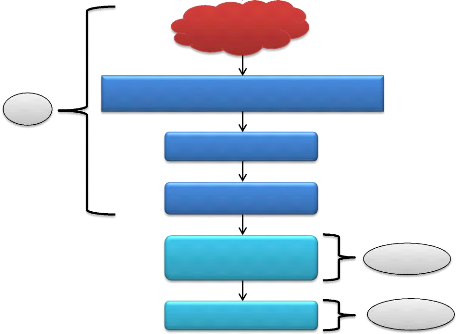
PSC
Selection and Prioritization
Project Identification
Management and Monitoring
Country Strategy
Need
Assessment
Evaluation
PT & PSC
PT
PSC: Programme Selection Committee
PT: Programme Team
Figure 6 Proposed Framework for Programme Selection and
Management
Needs' Assessment: This first stage is concerned
with the assessment of a country's needs which will be used when developing the
country's strategy.
Country Strategy: this stage is concerned with
the development of the country's strategy based on the needs identified during
the needs' assessment phase and the demand in the country.
Project Identification: this stage will consist
of a pre-screening and a screening process. Programme and project proposals
will be reviewed to ensure that they are in line with the country's strategy
(pre-screening) before they are matched to one of the strategic buckets
identified when developing the country's strategy (screening).
University Of Hertfordshire (2014)
University Of Hertfordshire (2014)
49
Proposals that are not aligned with the country's strategy will
be rejected and those that are aligned to the strategy and fit one of the
strategic buckets will be carried forward to the next phase.
Selection and Prioritization: during this stage,
programmes and projects will be scored and ranked using the weighted Scoring
Model developed for the framework. Programmes and projects with the highest
scores will then be carried forward to the next phase which is the
implementation.
The Programme Selection Committee will be responsible for the
above four phases.
Project Identification
|
- Pre-screening - Screening
|
Selection and Prioritization
Figure 7 Phases 1 and 2 of the proposed framework
Management and Monitoring: this phase is
concerned with the implementation of the programmes and projects under the
supervision of the Programme Team. The RAID Log of each individual programme or
project will be updated throughout its implementation and status reports will
also be prepared periodically. It is during this phase that programme and
project activities will be broken down into manageable work packages to
facilitate planning. Programmes and projects will go through their normal life
cycle until they are completed.
Evaluation: during this phase, the programmes
and projects outputs and outcomes will be reviewed and evaluated in contrast to
what was initially planned and lessons learnt report will be produced. This
evaluation phase will also be used to capture
University Of Hertfordshire (2014)
50
stakeholders' satisfaction. The evaluation phase will be under
the supervision of both the Programme Selection Committee and Programme
Team.
Management & Monitoring
|
- Progress Reports - RAID Log
|
Evaluation
|
- Final Report
- Lessons Learnt Report
- Stakeholder's satisfaction
|
Figure 8 Phases 3 and 4 of the proposed framework
University Of Hertfordshire (2014)
51
6. Conclusion
6.1 How is Project Portfolio Selection applied within an
Organisation
This research has shown that Project Portfolio Management links
an organisation's strategic goals and objectives to its project selection
process through the use of tools and techniques that ensure that the selected
projects or group of projects are aligned with the organisation's strategy. To
align an organisation's strategy to its programme or project selection process,
project portfolio management advocates the establishment of a management team
that will be responsible for the identification, screening, selection and
ranking of programmes and projects that will be implemented. By doing so,
organisations can be assured that only the right mix of programmes and projects
are selected.
6.2 What is the nature of International Development
Organisations as opposed to traditional Organisations
This research has shown that International Development
Organisations aim to improve the well-being of populations directly or
indirectly through programmes and projects. They therefore must adopt a
programme/project selection framework that not only support their strategies
but also put cost-effectiveness at its forefront. The findings revealed that
there is no universal framework that is used by all International Development
Organisations but that they all develop a framework that helps them implement
their strategies, suits their needs and make it easier for them to track
changes occurring throughout the implementation of programmes and projects
while at the same time making it possible to learn important lessons that will
help improve their organisational processes. As opposed to traditional
organisations, development organisations rely on non-financial models when
ranking and prioritizing projects. The use of non-financial models also results
from the humanitarian nature of these organisations.
6.3 What is the proposed framework for the selection and
management of International Development Programmes and Projects
The framework proposed in this dissertation follows Souder
(1973)'s criteria for project selection models in that it takes into account an
organisation's strategic objectives and its resources, it deals with
uncertainties by proposing the use of tools that help identify events that can
have a negative impact on the implementation of
University Of Hertfordshire (2014)
52
selected programmes and projects (RAID Log), it is flexible in
that it can be used by any development organisation, it is easy to understand
and use. The framework incorporates the principles of project portfolio
management by proposing the establishment of two management teams that will
ensure that only programmes and projects that are in line with an
organisation's strategy are selected and
implemented. The framework also incorporates some of the key
success factors proposed by Diallo and Thuillier (2004) mainly creating
learning opportunities and stakeholders' satisfaction therefore making it a
good alternative framework for the selection of development programmes and
projects.
University Of Hertfordshire (2014)
53
7. References
Ahsan, K., & Gunawan, I. (2010). Analysis of cost and
schedule performance of international development projects. International
Journal of Project Management, 28(1), 68-78.
Archer, N.P. and Ghasemzadeh, F. (1999). An Integrated
Framework for Project Portfolio Selection. International Journal of
Project Management, 17 (4), 207-216.
Association of Project Management. (2006). APM Body of
Knowledge, 5th ed. High Wycombe, UK: Author
Baum,W. C. (1970). The project cycle. Finance and
Development, 7(2), 2-13.
Bond, R., & Hulme, D. (1999). Process approaches to
development: Theory and Sri Lankan practice. World Development, 27(8),
1339-1358.
Chaffee, Ellen Earle. (1985). Three Models of Strategy.
The Academy of Management Review. 10 (1), 89-98.
Cooke-Davies, T. (2002). The «Real» Success Factors
on Projects. International Journal of Project Management, 20 (3),
185-190.
Cooper, R. G. (2005). Portfolio Management for Product
Innovation. In Levine, H. A. (eds.) (2005) Project Portfolio
Management: A Practical Guide to Selecting Projects, Managing Portfolios and
Maximizing Benefit, pp.318-354. USA: Pfeiffer Wiley.
Cooper, R. G., Edgett, S. J., & Kleinschmidt, E. J. (1998).
Best Practices for Managing R & D Portfolios,Research Technology
Management 41, 4: 20-33.
Cooper, R. G., Edgett, S. J., & Kleinschmidt, E. J. (2001).
Portfolio Management in New Product Development: Results of an Industry
Practices Study. R & D Management, 31 (4), 361-381.
Crawford, P. and Bryce, P. (2003), Project monitoring and
evaluation: a method for enhancing the efficiency and effectiveness of aid
project implementation, International Journal of Project Management, Vol.
21 No. 1, pp. 363-73.
Department for Internation Development. (2011). DFID's
Approach to Value for Money (vfm). Available at:
https://www.gov.uk/government/uploads/system/uploads/attachmentdata/file/67479/
DFID-approach-value-money.pdf. Last accessed 10th September 2014.
Dess, G.G., Lumpkin, G.T., 2005. The role of entrepreneurial
orientation in stimulating effective corporate entrepreneurship. The
Academy of Management Executive 19 (1), 147-156.
University Of Hertfordshire (2014)
54
Diallo, A. and Thuillier, D. (2004), The success dimensions
of international development projects: the perceptions of African project
coordinators, International Journal of Project Management, Vol. 22 No. 1,
pp. 19-31.
Diallo, A. and Thuillier, D. (2005), The success of
international development projects, trust and communication: an African
perspective, International Journal of Project Management, Vol. 23 No. 1,
pp. 237-52.
Diallo, A., & Thuillier, D. (2004). The success
dimensions of international development projects: The perceptions of African
project coordinators. International Journal of Project Management, 22(1),
19-31.
Diallo, A., & Thuillier, D. (2005). The success of
international development projects, trust and communication: An African
perspective. International Journal of Project Management, 23(3),
237-252.
Dye, L. D. & Pennypacker, J. S. (2000). Project Portfolio
Management and Managing Multiple Projects: Two Sides of the Same Coin?'
Proceedings of the Project Management Institute Annual Seminars &
Symposium, September 7-16, 2000. Houston, Texas, USA.
Dye, L.D. and Pennypacker, J.S. (eds.). (1999). Project
Portfolio Management: Selecting and prioritizing projects for competitive
advantage. West Chester, PA: Center for Business Practices.
Englund, R. L. & Graham, R. J. (1999). From Experience:
Linking Projects to Strategy. Journal of Production and Innovation
Management, 16 (1), 52-64.
Gardiner, P. D. (2005). Project Management: A Strategic
Planning Approach. UK: Palgrave Macmillan.
Ghasemzadeh, F. and Archer, N.P. (2000). Project portfolio
selection through decision support. Decision Support Systems. 29 (1),
73-88.
Hermano, V., López-Paredes. A., Martín-Cruz, N. and
Pajares, J.. (2013). How to manage international development (ID) projects
successfully. Is the PMD Pro1 Guide going to the right direction?
International Journal of Project Management. 31 (1), p22-30.
Ika, L. A., & Hodgson, D. (2010). Towards a critical
perspective in international development project management. Paper
presented at Making Projects Critical 5, Bristol Business School, Bristol,
England.
Ika, L. A., Diallo, A., & Thuillier, D. (2010). Project
management in the international development industry: the project coordinator's
perspective. International Journal of Managing Projects in Business, 3(1),
61-93.
55
University Of Hertfordshire (2014)
Ika, Lavagnon A. (2012). Project Management for Development
in Africa: Why Projects Are Failing and What Can Be Done About It.Project
Management Journal. 43 (4), 27-41.
Jankowicz, A.D (2005). Business Research Projects. 4th
ed. London: Thomson Learning. p111.
Johnson, G., Scholes, K. and Whittington, R. (2006).
Exploring Corporate Strategy. 7th ed. Harlow, Essex: Pearson Education
Limited.
Khang, Do Ba and Moe, Tun Lin. (2008). Success Criteria and
Factors for International Development Projects: A Life-Cycle-Based
Framework. Project Management Journal. 39 (1), 72-84.
LaBrosse, Michelle. (2010). Project-Portfolio
Management. Employment Relations Today. 37 (2), 75-79.
Landoni, Paolo and Corti, Benedetta. (2011). The Management
of International Development Projects: Moving Toward a Standard Approach or
Differentiation?. Project Management Journal. 42 (3), 45-61.
Lee, Nick and Lings, Ian (2008). Doing Business Research: A
Guide to theory and practice. London: SAGE Publications. p46-75.
Levine, H. A. (2005). Project Portfolio Management: A
Practical Guide to Selecting Projects, Managing Portfolios and Maximizing
Benefit. USA: Pfeiffer Wiley.
Meredith & Mantel-Jr, (2010). Project Management: A
Managerial Approach, 7th edition. New York, USA: John Wiley & Sons.
Mintzberg, H., Ahlstrand, B. & Lampel, J. (1998).
Strategy Safari: A Guided Tour through the Wilds of Strategic
Management. New York, USA: Free Press.
Morgan, E. P. (1983). The project orthodoxy in development:
Re-evaluating the cutting edge. Public Administration and Development,
3(4), 329-339.
Morgan, R.E., Strong, C.A., 2003. Business performance and
dimensions of strategic orientation. Journal of Business Research 56 (3),
163-176.
Müller, R., Martinsuo,M., and Blomquist, T. (2008).
Project portfolio control and portfolio management performance in different
contexts. Project Management Journal, 39 (3), pp. 28-42
University Of Hertfordshire (2014)
56
NORAD (1995). Guide to Planning and Evaluation NGO
Projects, Number 2: Core Elements in Planning Development Assistance,
Oslo: NORAD.
NORAD (1999). The Logical Framework Approach (LFA): Handbook
for Objectives-Oriented Project Planning.
PMD Pro (2013). A Guide to the PMD Pro Project Management for
Development Professionals. London: PM4NGOs.
Ramenyi, D., Williams, B., Money, A. and Swartz, E. (1998)
Doing Research in Business and Management: An Introduction to Process and
Method, London, Sage.
Rondinelli, D. A. (1976). Why development projects fail:
Problems of project management in developing countries. Project Management
Quarterly, 7(7), 10-15.
Rosenberg, L.J., Posner, L.D., 1979. The Logical Framework: A
Manager's Guide to a Scientific Approach to Design and Evaluation.
Practical Concepts, Washington,DC.
Saunders, M., Lewis, P. and Thornhill, A. (2007). Research
Methods for Business Students. 4th ed. Harlow: Pearson Education Limited.
p100-128.
Shenhar, A. J. & Wideman, R. M. (1997). Toward a
Fundamental Differentiation between Projects. [Accessed on:
16th June 2014] Available at:
http://www.maxwideman.com/papers/differentiation/background.htm
Shenhar, A.J., Dvir, D., Levy, O., Maltz, A.C., (2001).
Project success: a multidimensional strategic concept. Long Range
Planning 34 (6), 699-725.
Sommer, R. J. (1999). Portfolio Management for Projects: A
New Paradigm. In Dye, L.D. and Pennypacker, J.S. (eds.) (1999) Project
Portfolio Management: Selecting and Prioritizing Projects for Competitive
Advantage, pp. 55-60. West Chester, PA: Center for Business Practices.
Souder, E. William. (2000). Utility and Perceived
Acceptability of R&D Project Selection Models. Management Science. 19
(12), 1384-1394.
Srivannaboon, S. & Milosevic, D. Z. (2006). A Two-Way
Influence between Business Strategy and Project Management, International
Journal of Project Management, 24(6), 493-505.
Themistocleous, G. and Wearne, S.H. (2000), Project
management topic coverage in journals, International Journal of Project
Management, Vol. 8 No. 1, pp. 7-11.
Turner, J.R. (1994), Editorial: international project
management association global qualification, certification and
accreditation, International Journal of Project Management, Vol. 13 No. 3,
pp. 109-18.
University Of Hertfordshire (2014)
57
Walker, O.C,J., and Ruekert, R. W. (1987) Marketing's role in
the implementation of business strategies: a critical review and conceptual
framework. Journal of
Marketing, 51 (3), pp. 15-34
Yelin, K. C. (2005). Linking Strategy and Project Portfolio
Management. In Levine, H. A. (eds.) (2005) Project Portfolio
Management: A practical guide to selecting
projects, managing portfolios and maximizing benefit,
pp. 137-145. USA: Pfeiffer Wiley.
Youker, R. (1999). Managing international development
projects: Lessons learned. Project Management Journal, 30(2), 6-7.
Youker, R. (2003). The nature of international development
projects. Paper presented at PMI Conference, Baltimore, MD.
7.1 Referred Reports
ActionAid Strategy (2012 - 2017), ?People's Action to End
Poverty?. [Accessed on:
1st of August 2014] Available at:
http://www.actionaid.org/sites/files/actionaid/peoplesactiontoendpoverty28pp.p
df
ChristianAid (2012), ?How Christian Aid assesses Value for Money
in its programmes?. [Accessed on: 3rd of August 2014] Available at:
https://www.christianaid.org.uk/images/value-for-money.pdf
ChristianAid (2012), ?Partnership for Change: The Power to End
Poverty?. [Accessed on: 5th August 2014] Available at:
http://www.christianaid.org.uk/Images/2012strategy.pdf
OXFAM Annual Progress Report (2013), ?My Right, My Voice?.
[Accessed on: 8th of August 2014]
Available at:
http://policy-practice.oxfam.org.uk/publications/my-rights-my-voice-annual-progress-report-2013-317556
OXFAM Strategic Plan (2013 - 2017), ?The Power of People Against
Poverty?. [Accessed on: 11th August 2014] Available at:
University Of Hertfordshire (2014)
58
http://www.oxfam.org/en/countries/oxfam-strategic-plan-2013-2019-power-people-against-poverty
Plan International (2009), ?Programme Accountability and Learning
System (PALS)». [Accessed on: 15th August 2014] Available
at:
https://plan-international.org/about-plan/how-we-work/effectiveness/approach-programming-effectiveness/pals/
Plan International (2010), ?Promoting Child Rights to End
Poverty?. [Accessed on: 17th August 2014] Available at:
https://plan-international.org/about-plan/resources/publications/about-plans-work/promoting-child-rights-to-end-child-poverty-1/
Plan Worldwide Annual Review (2013). [Accessed on:
22nd August 2014] Available at:
https://plan-international.org/where-we-work/americas/publications/plan-worldwide-annual-review-2013
Water Aid (2012), [Accessed on: 24th August 2014]
?Sustainability Framework. [Accessed on: 16th June 2014] Available
at:
http://www.wateraid.org/uk/google-search?query=framework
Water Aid (2009 - 2015), ?Global Strategy?. [Accessed on:
24th June 2014] Available at:
http://www.wateraid.org/uk/who-we-are/annual-reports#/annual-reports
7.2 Reports Not Used
Action Against Hunger (2013), ?Aid for Nutrition?
http://www.actionagainsthunger.org.uk/resource-centre/online-library/detail/media/aid-for-nutrition-2013/
Common Wealth Secretariat (2013), ?Report of the Common Wealth
Secretariat?
http://thecommonwealth.org/sites/default/files/page/documents/Report%20of%20the
%20Commonwealth%20Secretary-General%202011-2013%20Low%20Res.pdf
Health Poverty Action (2012), ?Annual Review?
http://www.healthpovertyaction.org/wp-content/uploads/2014/01/Annual-Review-2012-13-web.pdf
International Development Institute (2013), ?Striving towards
2015 - IDS Annual Report?
http://www.ids.ac.uk/publication/striving-towards-2015-ids-annual-report
59
University Of Hertfordshire (2014)
International HIV/Aids Alliance (2014), ?Annual Report?
http://www.aidsalliance.org/resources/240-2013-report-and-accounts
International Rescue Committee (2013), ?Annual Report?
http://www.savethechildren.net/sites/default/files/SCIAR2013Interactive.pdf
Malaria Consortium (2012), ?Annual Review?
http://www.malariaconsortium.org/pages/annual
review 2011 2012.htm
Save the Children (2013), ?Annual Review?
http://www.savethechildren.net/sites/default/files/SCIAR2013Interactive.pdf
War Child UK (2013), ?Annual Report?
http://www.warchild.org.uk/about/publications/war-child-annual-report-2013
World Vision (2011), ?World Vision Strategy 2011 - 2015?
http://www.worldvision.org.uk/who-we-are/strategy/
University Of Hertfordshire (2014)
60
8. Personal Reflection
Looking back at what I have experienced when writing my
dissertation, I have realised that it was very enjoyable with many eye opening
moments. Having worked in the Development Sector for two years prior to coming
to England for my masters, I already knew that my research topic would be
centred on International Development Organisations in Africa and what can be
done to improve their project selection processes. My initial idea was to focus
on a single case study, the organisation I had been working for in Kenya for
two years but this quickly changed after conducting my literature review. I
started my research by conducting a literature review on project portfolio
management and international development projects in general. The literature
review on project portfolio management allowed me to understand what portfolio
management was about much more than when it was discussed in the classroom and
also introduced me to the three major frameworks associated with project
portfolio management and their different processes. The review of literature on
international development organisations introduced me to two frameworks I had
never heard about before, the Logical Framework Approach (LFA) and the Project
Management for Development Professionals (PMD Pro) with the LFA being the
blueprint used by development organisations when they design their own
programme selection frameworks. Designing my literature review in this manner
would later turn out to be beneficial for the remaining sections of my
dissertation. My initial plan was to use a single case study but following the
advice of my supervisor, I decided to focus on international development
organisations in the United Kingdom with the aim of getting information about
how they select their programmes and projects then use this information to
develop a framework that could be used by development organisations in Africa.
However, due to conflicting schedules and the responses I got after contacting
the fifteen organisations whose managers I wanted to interview, my supervisor
and I agreed that the collection of information would be done in the form of a
documentary analysis. I was sceptical at first because I did not believe that I
would get enough information from the annual reports and strategic plans of
these organisations but to my big surprise, they were really explicit about
their project selection processes. Out of the fifteen organisations I had
contacted, I decided to focus on five of them which gave a good representation
of the sectors in which most development organisations are involved in. cutting
down the number of organisations to study, simplified the analysis phase of my
dissertation because even though the
University Of Hertfordshire (2014)
61
information I needed could be found in the different reports
and strategic plans, it took a lot of time to collect it and make sense out of
it. Going through those different documents helped me find links between what I
presented in the literature review on international development organisations
and the content of the reports and strategic plans I had reviewed for the
analysis section of my dissertation. The Logical Framework approach, the
success factors for development projects and the lack of a project management
tools specifically designed for development projects were the topics that were
mostly discussed. These links allowed me to develop a framework built around my
experience in the development sector, the literature on project portfolio
management and the findings of my analysis.
The biggest challenge I faced throughout the process of
writing this dissertation was time management especially during the term time.
It wasn't easy for me to start working on my dissertation as it was outlined in
the Gantt chart I had submitted with my proposal, juggling between assignment
deadlines, preparing for exams, getting my Ethics Form approved and planning
interviews was not easy. One of the things I would differently would be to
contact the organisations I wanted to interview In January therefore giving
them enough time to schedule the interviews because even though the information
I got from the reports was relevant, interviewing project managers would have
added more to this research in terms of scope.
University Of Hertfordshire (2014)
62
Appendix 1 APPLICATION FOR ETHICAL APPROVAL OF A STUDY
INVOLVING HUMAN PARTICIPANTS
FORM EC1:
|
Relevant ECDA:
Science & Technology
Health & Human Sciences
|
OFFICE USE ONLY
Protocol Number:
|
|
|
Office Use only Date Received by Clerk:
|
|
Expedited Review
|
|
Approved by Reviewer 1 (sign & date)
|
Approved by Reviewer 2 (sign & date)
|
|
Further Action: (tick appropriate box and
provide details)
|
|
Request Further Information
|
|
Details:
|
|
Refer for Substantive Review
|
|
|
|
Refer for Full review
|
|
|
Reject
|
|
|
Substantive Review
|
|
Approved by Reviewer 1 (sign & date)
|
Approved by Reviewer 2 (sign & date)
|
|
Approved by Reviewer 3 (sign & date)
|
Approved by Reviewer 4 (sign & date)
|
|
Further Action: (tick appropriate box and
provide details)
|
|
Request Further Information
|
|
Details:
|
|
Refer for Full review
|
|
|
|
Reject
|
|
|
Full Review
|
|
Request Further Information
|
|
Details:
|
|
|
Reject
|
|
|
CONFIRMATION OF APPROVAL
[To be completed by the Chairman or Vice-Chairman of the
relevant ECDA, or by the Chairman of the University Ethics Committee -
(see GN 2.1.4)]
I confirm that this application has been approved by or on behalf
of the committee named below.
Name/Sign Date
Name of committee
|
63
DECLARATIONS
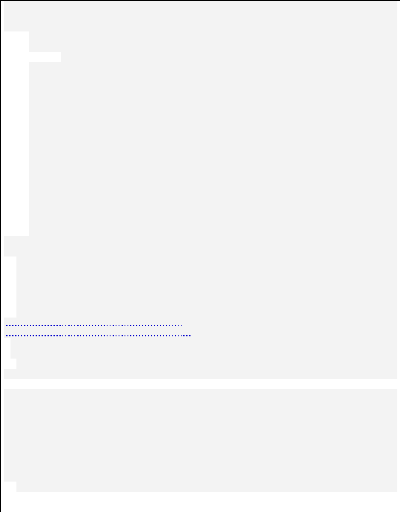
DECLARATION BY APPLICANT (See GN 2.1.3)
DECLARATION BY SUPERVISOR (see GN 2.1.3)
(Signature) (Name in BLOCK CAPITALS and
position within the School)
Enter your name here....LANDRY IRAGI MUGARUKA...Date...
If you are a member of staff, please obtain the
signature of your line manager to indicate their agreement to this
application:
Enter your name here...Date...
Where the participant is a minor or is otherwise unable, for any
reason, to give full consent on their own, references here to participants
being given an explanation or information, or being asked to give their
consent, are to be understood as referring to the person giving consent on
their behalf. (See Q 19 above; also GN Pt. 3, and especially 3.6 & 3.7)
I confirm that the proposed study has been appropriately vetted
within the School in respect of its aims and methods as a piece of research;
that I have discussed this application for Ethics Committee approval with the
applicant and approve its submission; and that I accept responsibility for
guiding the applicant so as to ensure compliance with the terms of the protocol
and with any applicable ethical code(s).
(i) I undertake, to the best of my ability, to abide by accepted
ethical principles in carrying out the study.
(iii) I undertake to explain the nature of the study and all
possible risks to potential participants, to the extent required to comply with
both the letter and the spirit of my replies to the foregoing questions
(including information contained in Appendices 1 & 2).
(v) Data relating to participants will be handled with great
care. No data relating to named or identifiable participants will be passed on
to others without the written consent of the participants concerned, unless
they have already consented to such sharing of data when they agreed to take
part in the study.
(vii) All participants will be informed (a)
that they are not obliged to take part in the study, and (b)
that they may withdraw at any time without disadvantage or having to
give a reason.
University Of Hertfordshire (2014)
University Of Hertfordshire (2014)
64
Instructions for Applicants
Applicants are advised to read the Guidance Notes before
completing this form. Use of this form is mandatory [see UPR RE01, SS
7.1 to 7.3]. Your School may choose to add additional School specific questions
in a separate appendix to the Form EC1. Please clarify with your Supervisor
whether your School has chosen to append any extra questions.
Approval must be sought and granted before any
investigation involving human participants begins [UPR RE01, S 4.4(iii)].
Abbreviations
GN=Guidance Notes
UPR=University Policies & Regulations
Q=Question
S=Section
SS=Sections
Pt =Part
PLEASE NOTE: Where alternative answers
are offered, put a cross in the appropriate box.
For example: X YES
Where a «write in» answer is requested, begin in the
space provided below the question and continue as necessary. All
questions must be answered. Please answer in BLACK.
65
1. THE STUDY

Q1. Please give the title (or provisional title)
of the proposed study. (NB - you will be asked for further details later)
Project Selection and Management in International Development
Organisations
2. THE APPLICANT

Status:
X
Q2. Please answer either Q2.1 or
Q2.2 by providing the information requested. Q2.1
should be answered by individual applicants, both staff and students,
who require protocol approval for work which they themselves intend to carry
out. Q2.2 should be answered by academic staff requiring
approval for standard protocols governing classroom practical work (or
equivalent work) to be carried out by a specified group of students. (See GN
2.2.1 & 2.2.19)
Q2.1. Name of applicant/(principal)
investigator
Programme of study or award (e.g. BA/MSc/PhD/Staff research)
MSc.
E-mail address
landrymugaruka@gmail.com
Name of supervisor
Mike Herman
Supervisor's contact details (email, extension number)
m.j.herman@herts.ac.uk
EXT: 5474
School/Department
(a) undergraduate
(b) postgraduate (taught/research)
(c) academic staff
(d) other - please give details here
University Of Hertfordshire (2014)
66

Please note: Risk Assessment Form EC5 is mandatory for
all Class Protocol Applications and must accompany this
application.
Q2.2. Class Protocol Applications
Only.
Name of applicant/(principal) investigator (member of staff)
School/Department
Programme of study or award (e.g. BSc/MA) Module Title
Year/group to be governed by the protocol
Number of students conducting the study Programme Tutor (if
different from the applicant) E-mail address
3. DETAILS OF THE PROPOSED STUDY

Q3. (a) Is it likely that your application will
require NHS approval? (See GN 2.2.2)
(b) Please confirm whether your research
involves any of the following:
NHS Patients
Clinical trial of an investigational product
X
YES NO
(If YES, please answer (b) &
(c)) (If NO, please continue on to Q4)
University Of Hertfordshire (2014)
67

If your study is likely to require NHS approval or is a
Clinical Trial of Investigational Medical Products or Devices, DO NOT complete
this form any further and submit it to your relevant ECDA at this stage. All
NHS applications must be made on an IRAS form. If your study is a Clinical
Trial of Investigational Medical Products or Devices involving one of the above
specified categories, you will be contacted by the relevant ECDA with
information on the next steps. Please note, you will be issues with a UH
Protocol Number but this will not be valid until you have sent your relevant
ECDA a copy of your NHS approval.
The aim of my dissertation is to find out how project selection
and management principles of Project Portfolio Management can be applied in
International Development
Organisation. My study's objective is to compare theory with
practice by analysing which techniques are commonly used in the portfolio
selection process in International Development Organisations, the impact that
the strategic objectives of these organisations have on their selection process
and the other factors that have an influence on the selection process. The
findings will be compared and contrasted to the project portfolio management
theory leading to the development of a framework that can be used by
International Development Organisations. The human participants involved in
this study
Q4. Please give a short synopsis of your
proposed study; stating its aims and highlighting, if appropriate, where these
aims relate to the use of human participants. (See GN 2.2.3) Please enter
details here.
(c) Please confirm whether this study is
considered to be a Clinical Trial of Investigational Medical Products (CTIMP)
or Clinical Trial of Investigational Medical Devices. (See GN 2.2.2)
If YES, please indicate if the study involves any of the
following categories:
Adults who lack the capacity to consent
Pregnant women
A group of more than 5,000 people
Study would be undertaken overseas
Clinical trial of a medical device Exposure to any ionising
radiation
Children under 5
Human Tissue
YES
X
NO
University Of Hertfordshire (2014)
68

will be the project managers involved in the selection of
projects in their respective organisations.
Q5. Please give a brief explanation of the design of the study
and the methods and procedures used, highlighting in particular where these
involve the use of human participants. You should clearly state the nature of
the involvement the human participants will have in your proposed study and the
extent of their commitment. Thus you must complete and attach the Form EC6
(Participant Information Sheet) (see Appendix 2). Be sure to
provide sufficient detail for the Committee to be clear what is involved in the
proposed study, particularly in relation to the human participants. (See GN
2.2.4)
The study will be divided in two parts: the first part will be a
review of literature on Project Portfolio selection and management and the
second will be a study of the techniques used and other factors that have a
direct influence on project selection in UK based International development
organisations. The human participants' views will be captured through written
and oral interviews (Skype, telephone) and the findings will be summarized and
used to develop a project selection framework for International Development
Organisations.
Q7. Please give the starting date and finishing date. (For
meaning of «starting date» and «finishing date», see GN
2.2.5)
Q9. Where will the study take place? (If this is on UH Campus,
who will permission be obtained from e.g. your Module Leader, Programme Tutor,
Pro-Vice Chancellor (Student Experience) or the Dean of Students. If this is
NOT on UH Campus, please attach a copy of the written permission, given by the
proprietor, manager or other person with such authority over the premises, to
use the premises for the purposes of carrying out this research (see Appendix
2)) (See GN 2.2.6)
Please enter details here.
Telephone/ Skype/ Written all from my home. I do not intend to
visit other locations.
Q10. If the location is off campus, have you considered whether
a risk assessment is necessary for the proposed location? (in respect of
hazards/risks affecting both the participants and researchers) Please see
Form EC5 (see Appendix 2, which is an example of a risk
assessment form.) Please use this example if a risk assessment is necessary,
and you have not been provided with a subject specific risk assessment form by
your School or Supervisor. (See GN 2.2.7)
Q12. (a) Will anyone other than yourself and
the participants be present with you when conducting this study? (See GN
2.2.8)
Starting Date 01/05/2014
Finishing Date: 22/09/2014, the day before the final
submission
N/A
YES
X
NO
University Of Hertfordshire (2014)
69

If YES, please state the relationship between anyone else who
is present other than the applicant and/or participants? (e.g. health
professional, parent/guardian)
(b) Will the proposed study be conducted in
confidence? If NOT, what steps will be taken to ensure confidentiality of the
participants' information. (See GN 2.2.8)
4. HARMS, HAZARDS & RISKS
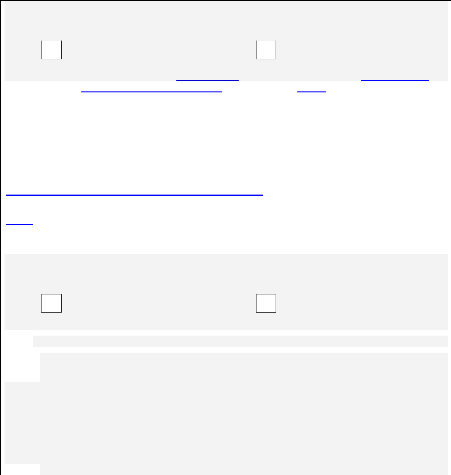
Note: You are advised to read GN 2.2.10, 2.2.11, 2.2.12
& 2.2.13 carefully before you answer the following questions.
Q10. Will this study involve invasive procedures on the human
participants? (See GN 2.2.9)
Q11, Q12, Q13 & Q14 - NON INVASIVE STUDIES
ONLY
Q12. Are there potential hazards to participant(s) and/or
investigator(s) from the proposed study? (See 2.2.10)
If YES,
(a) Indicate their nature here.
(c) Indicate here what precautions will be taken to avoid or
minimise any adverse effects.
Yes
(If YES, please fill out Appendix 1 - (If
NO, answer Q11, Q12, Q13
Increased Hazards and Risks. &
Q14)
Once this is complete, move on to Q15)
YES
X
X
No
NO
University Of Hertfordshire (2014)
70

X
NO
YES
YES
NO
X
Q13. Will or could medical or other aftercare and/or support be
needed by participants and/or investigator(s) as a result of the study? (See GN
2.2.12)
Q15. (a) If you have answered `YES' to
Q11, Q12 & Q13, please state here the previous experience
(and/or any relevant training) of the supervisor (or academic member of staff
applying for a standard protocol) of investigations involving the hazards,
risks, discomfort or distress detailed in those answers. (See GN 2.2.13)
(a) Indicate its nature here.
(c) Indicate here what precautions will be taken to avoid or
minimise such adverse effects.
(b) Please describe in appropriate detail what
you would do should the adverse effects or events which you believe could arise
from your study, and which you have mentioned in your replies to the previous
questions, occur.
(See UPR RE01, S 2.3 (ii) and GN 2.2.13)
Q12. Will or could the study cause discomfort or
distress of a mental or emotional character to participants and/or
investigator(s)? (See NG 2.2.11)
If YES,
University Of Hertfordshire (2014)
71
5. ABOUT YOUR PARTICIPANTS

Q15. Please give a brief description of the kind of people you
hope/intend to have as participants, for instance, a sample of the general
population, University students, people affected by a particular medical
condition, children aged 5 to 7, employees of a particular firm, people who
support a particular political party.
Q17. Please state here approximately how many participants you
hope will participate in your study.
I intend to send a questionnaire to different project/programme
managers in UK based
International Development Organisations. The UK based
International Development
Organisations identified are:
- Bond for International Development
- World Development Movement
- Hope International Development Agency
- OXFAM UK
- Action Aid UK
- Adam Smith International
- British Council
- Christian Aid
- Common Wealth Secretariat
- Crown Agents
- CDC Group
- Save the Children UK
- GRM International
- Help Age International
- Garfield Weston Foundation
- Tree Aid
- Charities Aid Foundation
- Department for International Development
- UK Trade and Investment
- The Overseas Development Institute
- Action Against Hunger
- Health Poverty Action
- International Development Institute
- International HIV/Aids Alliance
- International Rescue Committee
- Malaria Consortium
- War Child UK
My ongoing research may establish contact with similar IDOS.
University Of Hertfordshire (2014)
72

Initial contact will be made via email to present the research
topic and inquire about the willingness of the project/programme managers to
take part in the study. Since I have worked for the Centre for the Development
of Entreprise (CDE), I already have credibility and contacts in the
International Development community. The second part will be giving an
explanation of how their views on the practices they used to select projects
will be gathered through the written interview and if possible a telephone or
Skype interview. Information on the confidentiality of the study will also be
given to the participants.
Q17. By completing this form, you are indicating
that you are reasonably sure that you will be successful in obtaining the
number of participants which you hope/intend to recruit. Please outline here
how you intend to recruit them. (See GN 2.2.14)
My target is10 to 12 participants but I will attempt to contact
about twice this number.
6. CONFIDENTIALITY AND CONSENT

Q18. Is it intended to seek informed consent from the
participants?
Q20. If the participant is a minor (under 18 years of age), or
is otherwise unable for any reason to give full consent on their own, state
here whose consent will be obtained and how? (See especially GN 3.6 &
3.7)
[For guidance on issues relating to consent, see GN 2.2.15 &
Pt. 3.]
N/A
(See UPR RE01, S 2.3 & 2.4 and GN 3.1)
If NO, please explain why it is considered unnecessary or
impossible or otherwise inappropriate to seek informed consent.
If YES, please attach a copy of the Consent Form to be used (See
Form EC3 & EC4 for reference and GN 3.2), or describe here how consent is
to be obtained and recorded. The information you give must be sufficient to
enable the Committee to understand exactly what it is that prospective
participants are being asked to agree to.
X
YES NO
University Of Hertfordshire (2014)
73

All the data will be encrypted and stored on my password
protected laptop.
Q20. Are personal data of any sort (such as name, age, gender,
occupation, contact details or images) to be obtained from or in respect of any
participant? (See GN 2.2.16)
The data will be stored on my password protected laptop during
the project until the dissertation has been marked, moderated and the final
assessment verified by the University.
Q22. Is it intended (or possible) that data might be used beyond
the present study? (See GN 2.2.16)
Name, occupation, contact details and employer's name. The
information will be stored in my password protected laptop and encrypted on my
personal storage devices.
(c) Indicate here what assurances will be given to participants
about the security of, and access to, personal data.
If YES,
(a) Give details here of personal data to be gathered, and
indicate how it will be stored.
(c) State here what steps will be taken to prevent or regulate
access to personal data beyond the immediate investigative team?
(d) State here, as far as you are able to do so, how long
personal data collected during the study will be retained, and what
arrangements have been made for its secure storage.
If YES, please give here an indication of the kind of further
use that is intended (or which may be possible).
X
YES
YES
X
NO
NO
University Of Hertfordshire (2014)
74
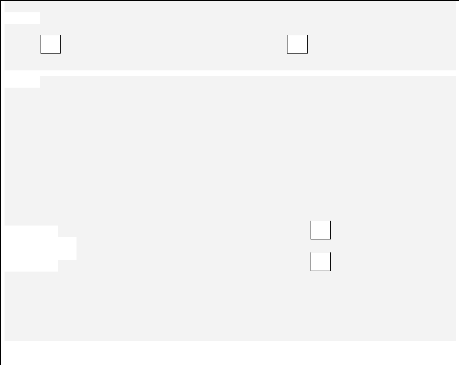
If a satisfactory CRB Disclosure is required, a copy of this
must be attached to Appendix 2 in order for reviewers to be able to consider
your application.
Q22. If your study involves work with children
and/or vulnerable adults you will require a satisfactory Enhanced Criminal
Records Bureau Disclosure. (See GN 2.2.17) Please indicate as appropriate:
If NO, will the data be kept for a set period and then destroyed
under secure conditions?
If NO, please explain here why not.
X
(a) CRB Disclosure not required
(c) CRB Disclosure required and obtained
YES
NO
7. REWARDS

Q23. (a) Are you receiving any financial or
other reward connected with this study? (See UPR RE01, 2.3)
(b) Are participants going to receive any
financial or other reward connected with the study?
If YES, give details here.
If YES, give details here.
YES
YES
X
X
NO
NO
University Of Hertfordshire (2014)
75

(c) Will anybody else (including any other
members of the investigative team) receive any financial or other reward
connected with this study?
If YES, give details here.
YES
X
NO
University Of Hertfordshire (2014)
8. OTHER RELEVANT MATTERS
|
Q24. Enter here anything else you want to say in
support of your application, or which you believe may assist the Committee in
reaching its decision.
|

(e) Indicate here what precautions will be taken to avoid or
minimise any adverse effects.
University Of Hertfordshire (2014)
76
APPENDIX 1 - INCREASED HAZARDS AND RISKS
This section is to be completed if your answer to Q10 affirms the
USE OF INVASIVE PROCEDURES in your study.
Note: You are advised to read GN 2.2.10, 2.2.11, 2.2.12,
2.2.13 & 2.2.18 carefully before you answer the following questions.
QA1. Please give details of the procedures to be used (e.g.
injection of a substance, insertion of a catheter, taking of a blood or saliva
sample), and any harm, discomfort or distress that their use may cause to
participants and/or investigator(s). (See GN 2.2.10)
|
|
(a) Indicate here what precautions will be
taken to avoid or minimise any adverse effects.
QA2. Will the study involve the administration of any
substance(s)? (See GN 2.2.10)
X
YES NO
|
If YES,
(a) Give details here of the substance(s), the dose or amount to
be given, likely effects (including duration) and any potential hazards to
participant(s) and/or investigator(s).
|
77

QA3. Are there any potential hazards to participant(s) and/or
investigator(s) arising from the use of the proposed invasive procedures? (See
GN 2.2.10)
QA5. Will or could the study cause discomfort or distress of a
mental or emotional character to participants and/or investigator(s)? (See GN
2.2.11)
(a) Indicate their nature here.
(c) Indicate here what precautions will be taken to avoid or
minimise any adverse effects.
If YES,
(a) Indicate its nature here
(c) Indicate here what precautions will be taken to avoid or
minimise such adverse effects.
If YES,
YES
YES
X
NO
X
NO
University Of Hertfordshire (2014)
78

QA5. Medical or other aftercare and/or support must be made
available for participants and/or investigator(s) who require it where invasive
procedures have been used in the study. Please detail what aftercare and/or
support will be available and in what circumstances it is intended to be used.
(See UPR RE01, S 2.3 (ii) and GN 2.2.12)
QA7. (a) Please state here previous experience
(and/or any relevant training) of the supervisor (or academic member of staff
applying for a standard protocol) of investigations involving hazards, risks,
discomfort or distress as specified. (See GN 2.2.13)
QA9. In the event that the study reveals that a participant has
a pre-existing medical condition (of which they may or may not be aware), and
which could affect their present or future health or that of others, they
should be informed of this in an appropriate manner and advised of follow-up
action that they should take. (See GN 2.2.18) Advice should be sought as to
whether information should be passed to their GP and a decision taken whether
they should be allowed to continue to take part in the study. If a
potential participant is not willing to agree to such action being taken
in these circumstances, they should not be allowed to take part in the study.
Please indicate here what arrangements have been made for complying with these
requirements.
(b) Please describe in appropriate detail what
you would do should the adverse effects or events which you believe could arise
from your study, and which you have mentioned in your replies to the previous
questions, occur.
University Of Hertfordshire (2014)
79
Please revert to Q15.
University Of Hertfordshire (2014)
University Of Hertfordshire (2014)
80
Appendix 2 Dissertation Proposal
Background
The aim of my dissertation is to find out how the Project
Selection and Management principles of Project Portfolio Management can be
applied in International Development Organisation. I am interested in the
selection of projects and their management in International Development
Organisations because of the two years I spent working in a Private Sector
Development Organization in East Africa. Project Selection was one our biggest
challenge because of the strategic objective of the organisation which was to
develop the private sector in East Africa by making local private companies
more competitive regionally and also making it possible for them to access new
markets. The only way through which we could make it possible for these
companies to benefit from our support (both technical and financial) was
through the implementation of projects. The projects were proposed by the local
companies and our job was to select the right projects for our
portfolios. Using a Balanced Scorecard method, we were able to rank and
prioritise projects and decide how our budget will be spread amongst them. This
method however, did not guarantee that the projects would be completed within
the agreed cost, scope and time and that the projects deliverables were still
in line with our strategic objectives. This led me to conclude that something
must have been wrong with our selection process and the way we monitored the
progress of our projects once they were given the green light. Different
studies demonstrate that many organizations have been trying to implement
projects that support or are closely tied to their goals and strategy (Meredith
& Mantel, 2010; Gardiner, 2005) and it has also been proven that projects
under implementation in most cases have little or no apparent link to the
Organisation's strategy and goals (Englund & Graham, 1999). These
observations make my research relevant in that I am trying to come up with a
way of implementing the principles of project selection and management embedded
in Project Portfolio Management in International Development Organizations to
ensure that the right projects are selected and that they are managed the right
way.
Project Portfolio Management is the management of project
pipeline so as to make project contribute to the overall organisation success
by bridging the gap between
University Of Hertfordshire (2014)
81
operations management and project management (Levine, 2005).
LaBrosse (2010) argues that Project Portfolio Management is a way for
organizations to analyse and manage in a coordinated way a group projects to
reap benefits not available if they were managed individually with the goal of
finding the best mix and timing of current projects to achieve the
organization's overall goals. My intention is to focus on two main aspects of
Portfolio Management: the selection of projects and the monitoring and control
of projects. I will aim to find out what is being proposed by different authors
and practitioners in the Project Portfolio Management field about the selection
of projects and the alignment of the project selection process with strategic
objectives and how it can be used to control the progress of projects while at
the same time making sure that criteria tested during the selection process are
still viable throughout the implementation phase. My research will look at how
the principles of Project Portfolio Management can be applied by
International Development Organizations to ensure that the right
projects are selected and to facilitate proper project progress monitoring
and control.
Research Questions
- to understand how project portfolio selections can applied
within an organisation
- to understand the nature of International Development
Organisations as
opposed to traditional project-based organisations, and
- to propose a framework for the selection and management of
programmes
and projects in International Development Organisations
-
Method
Using an interpretive philosophical perspective, I will review
the literature on Project Portfolio Management to understand how it can be
applied in an organization and the benefits it presents. I will also review the
literature on International development projects to understand their nature,
what makes them different from other types of projects and their critical
success factors. Fifteen UK-based Development organisations will be contacted
for this research with the aim of understanding how the way they select
programmes and projects for their portfolios. The data will be collected in the
form of written questionnaires that will be sent to the project managers and
members of the project selection committees of the selected
University Of Hertfordshire (2014)
82
organisations. Using multiple case studies will help me compare
and contrast the project selection process of these organisations and also spot
any differences between project selection theory and practice if they exist.
Timescale
The first milestone of my Dissertation is the submission of the
Draft Proposal and the First Information Form on the 3rd of February
2014. Following the submission of the Draft and FIF, the final research design
will be submitted on the 28th of February 2014. I have allocated
myself 21 days to conduct a thorough review of literature on Project Portfolio
Management from the 3rd of March to the 31st of March
2014 to come up with a Draft literature review. Twenty days have also been
allocated for the analysis of secondary data on Project Selection in
International Development Organisations and to get a feedback on the written
interview that will be sent to the selected International Development
Organisations from 1st of April to the 30th of April
2014. The dissertation draft preparation will take forty four days giving me
enough time to put together the information collected under the supervision of
my assigned research supervisor from the 1st of May to the
1st of July 2014. The submission of the first dissertation draft
will be done during the month of August 2014 leading to the submission of the
Final Dissertation on the 23rd of September.
83
University Of Hertfordshire (2014)
|
Activities
|
Januar
y
|
February
|
March
|
April
|
May
|
June
|
July
|
August
|
September
|
|
Preparation of FIF
|
|
|
|
|
|
|
|
|
|
|
Submission of FIF
and Research
Proposal
|
|
|
|
|
|
|
|
|
|
|
Submission of Draft
Research Design
|
|
|
|
|
|
|
|
|
|
|
Review of Literature
& Preparation of
Draft
|
|
|
|
|
|
|
|
|
|
|
Analysis of Primary
Data
|
|
|
|
|
|
|
|
|
|
|
Dissertation Draft
Preparation
|
|
|
|
|
|
|
|
|
|
Submission of Final
Dissertation Draft
|
|
|
|
|
|
|
|
|
|
|
Review of work
|
|
|
|
|
|
|
|
|
|
|
Submission of
Dissertation
|
|
|
|
|
|
|
|
|
|
University Of Hertfordshire (2014)
84
Potential Problems/Limitations
Literature on International Development Organisations is limited
with many authors on focussing on the skills and attribute of project managers
in the development sector and not the programme selection process which might
lead to having the same authors cited repeatedly throughout the dissertation.
Not getting enough responses from the organisations selected might have an
impact on the whole research because the aim of the research is to compare and
contrast the project selection processes of these organisations then propose a
framework that they can apply when selecting programmes and projects.
References
Englund, R. L. & Graham, R. J. (1999). From Experience:
Linking Projects to Strategy.. Journal of Production and Innovation
Management. 16 (1), 52-64. Gardiner, P. D. (2005). Project Management:
A Strategic Planning Approach. UK: Palgrave Macmillan. p81
LaBrosse, Michelle. (2010). Project-portfolio management.
Employment relations today 37.2 : p75-79.
Meredith, Jack R. and Mantel, Samuel J. (2010). Project
Management: A Managerial Approach. 7th ed. Asia: John Wiley & Sons.
p37-106.
Saunders, M., Lewis, P. and Thornhill, A. (2012) Research
methods for business students 6th edn. Pearson
85
University Of Hertfordshire (2014)
Actual Timescale
|
Activities
|
Januar
y
|
February
|
March
|
April
|
May
|
June
|
July
|
August
|
September
|
|
Preparation of FIF
|
|
|
|
|
|
|
|
|
|
|
Submission of FIF
and Research
Proposal
|
|
|
|
|
|
|
|
|
|
|
Submission of Draft
Research Design
|
|
|
|
|
|
|
|
|
|
|
Completion of
Chapter 1
|
|
|
|
|
|
|
|
|
|
|
Review of Literature
& Preparation of
Draft
|
|
|
|
|
|
|
|
|
|
|
Drafting the
Methodology
|
|
|
|
|
|
|
|
|
|
|
Drafting the Finding
and Analysis
Section
|
|
|
|
|
|
|
|
|
|
|
Submission of Final
Dissertation Draft
|
|
|
|
|
|
|
|
|
|
University Of Hertfordshire (2014)
86
The actual timeline I followed differs from the one I had planned
when submitting my proposal because of two main reasons:
- Preparation of Semester B exams - The change in research
scope
These changes in schedule had an impact on the Literature Review,
Methodology and the Findings and Analysis section of the dissertation in terms
of completion time and draft preparation. The change of scope was initiated in
the month of April when the project managers contacted for the interviews, due
to conflicting schedules, redirected me to the different Annual Reports and
Strategic Plans. The impact of this change is that I now had to find these
documents and read them to find out if they contained the information I
required. The month of May was split between preparing for Semester B's final
exams and working on the Literature Review for which I produced a draft on the
23rd of May. In the month of June, I started to work on the
Methodology section and I also started to extract the information I needed from
the different reports in order to compare the sampled organisations. The draft
was completed on the 22nd of June and was refined throughout the
month of July. I started to work on my Findings in that same month and by
mid-August, I had already produced a draft of the Findings and Analysis Section
which was later on refined in early September.
University Of Hertfordshire (2014)
87
Appendix 3 Dissertation Log
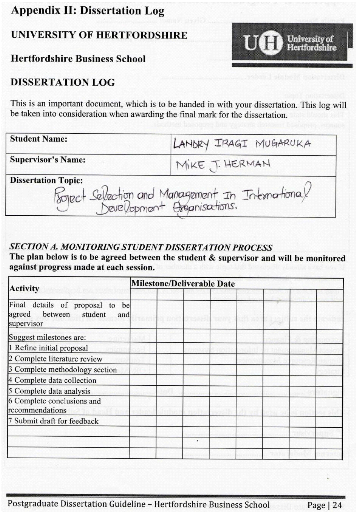
University Of Hertfordshire (2014)
88
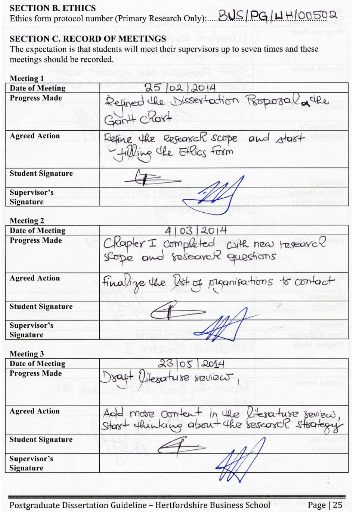
University Of Hertfordshire (2014)
89
Meeting 4
|
Date of Meeting
|
|
t 2J G C- i
|
t- 4
|
|
|
Progress Made
|
tL _
1Y1e
|
QeUr{'er., J
( Îr1)
c f' 4
|
ie cz on c
|
|
Agreed Action
|
r I
Li-P-e
|
+utd_Lf
|
I
|
|
|
Student Signature
|
L-
Signature
|
|
|
ji
|
|
|
Supervisor's
|
Meeting 5
|
Date of Meeting
|
|
|
,a2 1 06 r € o
/ 1
|
|
Progress Made
|
|
|
|
|
Agreed Action
|
_--1-.04
|
4
|
,~-~ (p_ e ,DL er
r
|
|
Student Signature
|
|
|
|
|
Supervisor's Signature
|
|
|
-»_.4-1
|
Meeting 6
|
Date of Meeting
|
r) I
1Q.014-1
|
|
Progress Made
|
8 egicOeI v "IT
|
|
Agreed Action
|
Tsepcose ''n Q 4 j op w _in
|
|
Student Signature
|
|
|
< -----
1E, f Ale
7,1+0 /,
|
|
Supervisor's Signature
|
Postgraduate Dissertation Guideline - Hertfordshire Business
School Page 1 26
| 


